Impact of Service Orientation on Manufacturing
VerifiedAdded on 2020/06/04
|23
|4790
|68
AI Summary
This assignment examines the influence of service orientation on business performance within the context of manufacturing companies. It delves into relevant research and case studies to understand how adopting a service-oriented approach can positively impact various aspects of manufacturing businesses, such as customer satisfaction, employee engagement, and operational efficiency. The assignment also explores potential challenges and strategies for successfully implementing service orientation in a manufacturing environment.
Contribute Materials
Your contribution can guide someone’s learning journey. Share your
documents today.
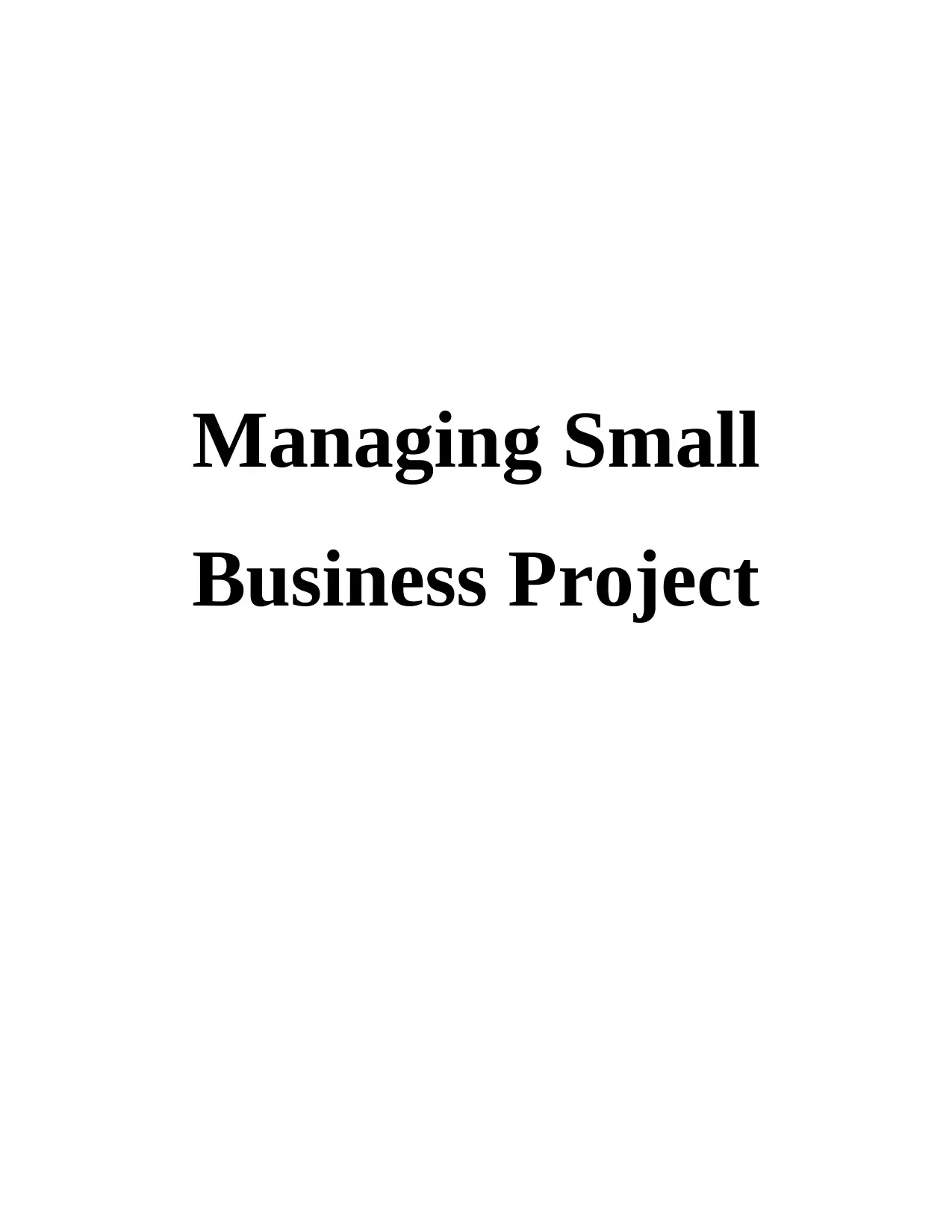
Managing Small
Business Project
Business Project
Secure Best Marks with AI Grader
Need help grading? Try our AI Grader for instant feedback on your assignments.
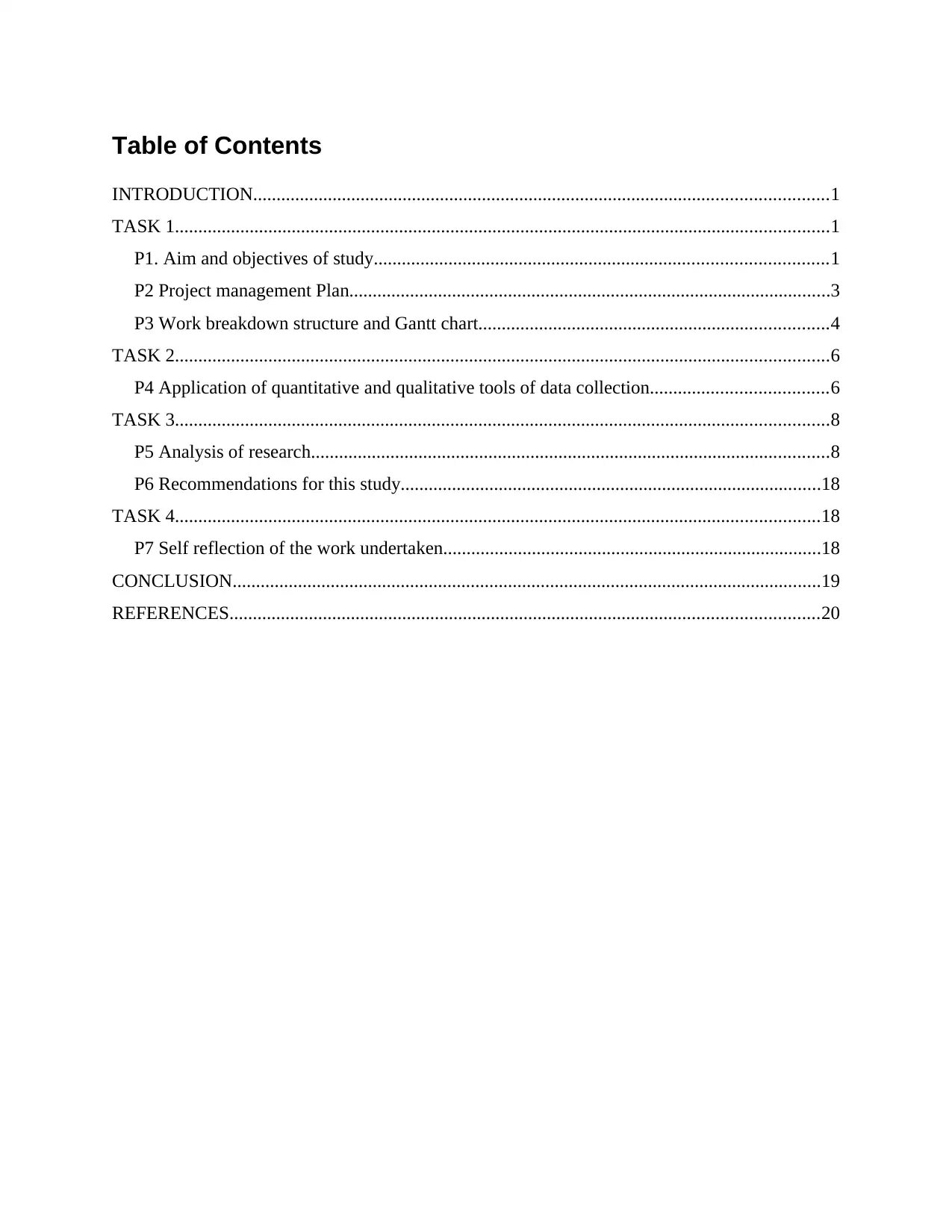
Table of Contents
INTRODUCTION...........................................................................................................................1
TASK 1............................................................................................................................................1
P1. Aim and objectives of study.................................................................................................1
P2 Project management Plan.......................................................................................................3
P3 Work breakdown structure and Gantt chart...........................................................................4
TASK 2............................................................................................................................................6
P4 Application of quantitative and qualitative tools of data collection......................................6
TASK 3............................................................................................................................................8
P5 Analysis of research...............................................................................................................8
P6 Recommendations for this study..........................................................................................18
TASK 4..........................................................................................................................................18
P7 Self reflection of the work undertaken.................................................................................18
CONCLUSION..............................................................................................................................19
REFERENCES..............................................................................................................................20
INTRODUCTION...........................................................................................................................1
TASK 1............................................................................................................................................1
P1. Aim and objectives of study.................................................................................................1
P2 Project management Plan.......................................................................................................3
P3 Work breakdown structure and Gantt chart...........................................................................4
TASK 2............................................................................................................................................6
P4 Application of quantitative and qualitative tools of data collection......................................6
TASK 3............................................................................................................................................8
P5 Analysis of research...............................................................................................................8
P6 Recommendations for this study..........................................................................................18
TASK 4..........................................................................................................................................18
P7 Self reflection of the work undertaken.................................................................................18
CONCLUSION..............................................................................................................................19
REFERENCES..............................................................................................................................20
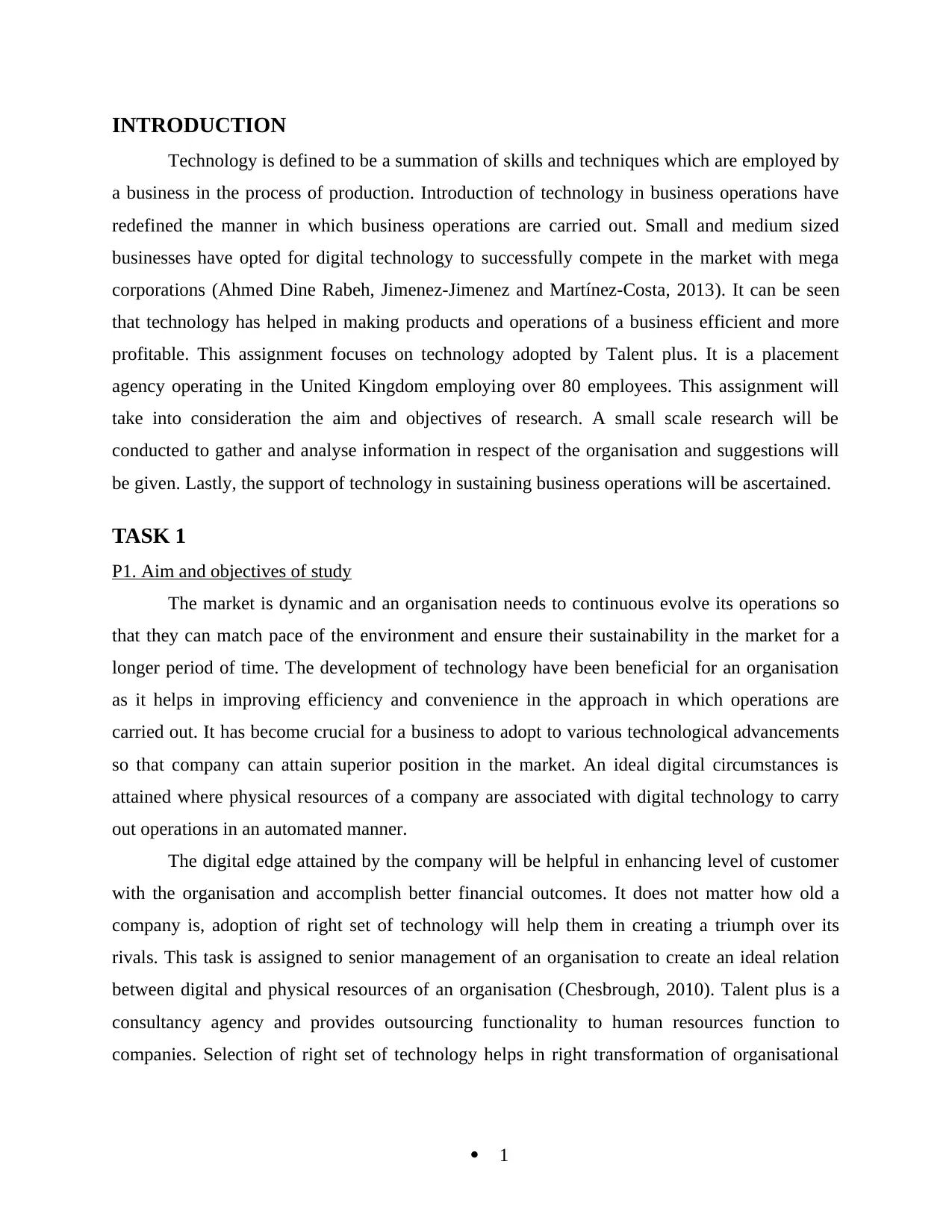
INTRODUCTION
Technology is defined to be a summation of skills and techniques which are employed by
a business in the process of production. Introduction of technology in business operations have
redefined the manner in which business operations are carried out. Small and medium sized
businesses have opted for digital technology to successfully compete in the market with mega
corporations (Ahmed Dine Rabeh, Jimenez-Jimenez and Martínez-Costa, 2013). It can be seen
that technology has helped in making products and operations of a business efficient and more
profitable. This assignment focuses on technology adopted by Talent plus. It is a placement
agency operating in the United Kingdom employing over 80 employees. This assignment will
take into consideration the aim and objectives of research. A small scale research will be
conducted to gather and analyse information in respect of the organisation and suggestions will
be given. Lastly, the support of technology in sustaining business operations will be ascertained.
TASK 1
P1. Aim and objectives of study
The market is dynamic and an organisation needs to continuous evolve its operations so
that they can match pace of the environment and ensure their sustainability in the market for a
longer period of time. The development of technology have been beneficial for an organisation
as it helps in improving efficiency and convenience in the approach in which operations are
carried out. It has become crucial for a business to adopt to various technological advancements
so that company can attain superior position in the market. An ideal digital circumstances is
attained where physical resources of a company are associated with digital technology to carry
out operations in an automated manner.
The digital edge attained by the company will be helpful in enhancing level of customer
with the organisation and accomplish better financial outcomes. It does not matter how old a
company is, adoption of right set of technology will help them in creating a triumph over its
rivals. This task is assigned to senior management of an organisation to create an ideal relation
between digital and physical resources of an organisation (Chesbrough, 2010). Talent plus is a
consultancy agency and provides outsourcing functionality to human resources function to
companies. Selection of right set of technology helps in right transformation of organisational
1
Technology is defined to be a summation of skills and techniques which are employed by
a business in the process of production. Introduction of technology in business operations have
redefined the manner in which business operations are carried out. Small and medium sized
businesses have opted for digital technology to successfully compete in the market with mega
corporations (Ahmed Dine Rabeh, Jimenez-Jimenez and Martínez-Costa, 2013). It can be seen
that technology has helped in making products and operations of a business efficient and more
profitable. This assignment focuses on technology adopted by Talent plus. It is a placement
agency operating in the United Kingdom employing over 80 employees. This assignment will
take into consideration the aim and objectives of research. A small scale research will be
conducted to gather and analyse information in respect of the organisation and suggestions will
be given. Lastly, the support of technology in sustaining business operations will be ascertained.
TASK 1
P1. Aim and objectives of study
The market is dynamic and an organisation needs to continuous evolve its operations so
that they can match pace of the environment and ensure their sustainability in the market for a
longer period of time. The development of technology have been beneficial for an organisation
as it helps in improving efficiency and convenience in the approach in which operations are
carried out. It has become crucial for a business to adopt to various technological advancements
so that company can attain superior position in the market. An ideal digital circumstances is
attained where physical resources of a company are associated with digital technology to carry
out operations in an automated manner.
The digital edge attained by the company will be helpful in enhancing level of customer
with the organisation and accomplish better financial outcomes. It does not matter how old a
company is, adoption of right set of technology will help them in creating a triumph over its
rivals. This task is assigned to senior management of an organisation to create an ideal relation
between digital and physical resources of an organisation (Chesbrough, 2010). Talent plus is a
consultancy agency and provides outsourcing functionality to human resources function to
companies. Selection of right set of technology helps in right transformation of organisational
1
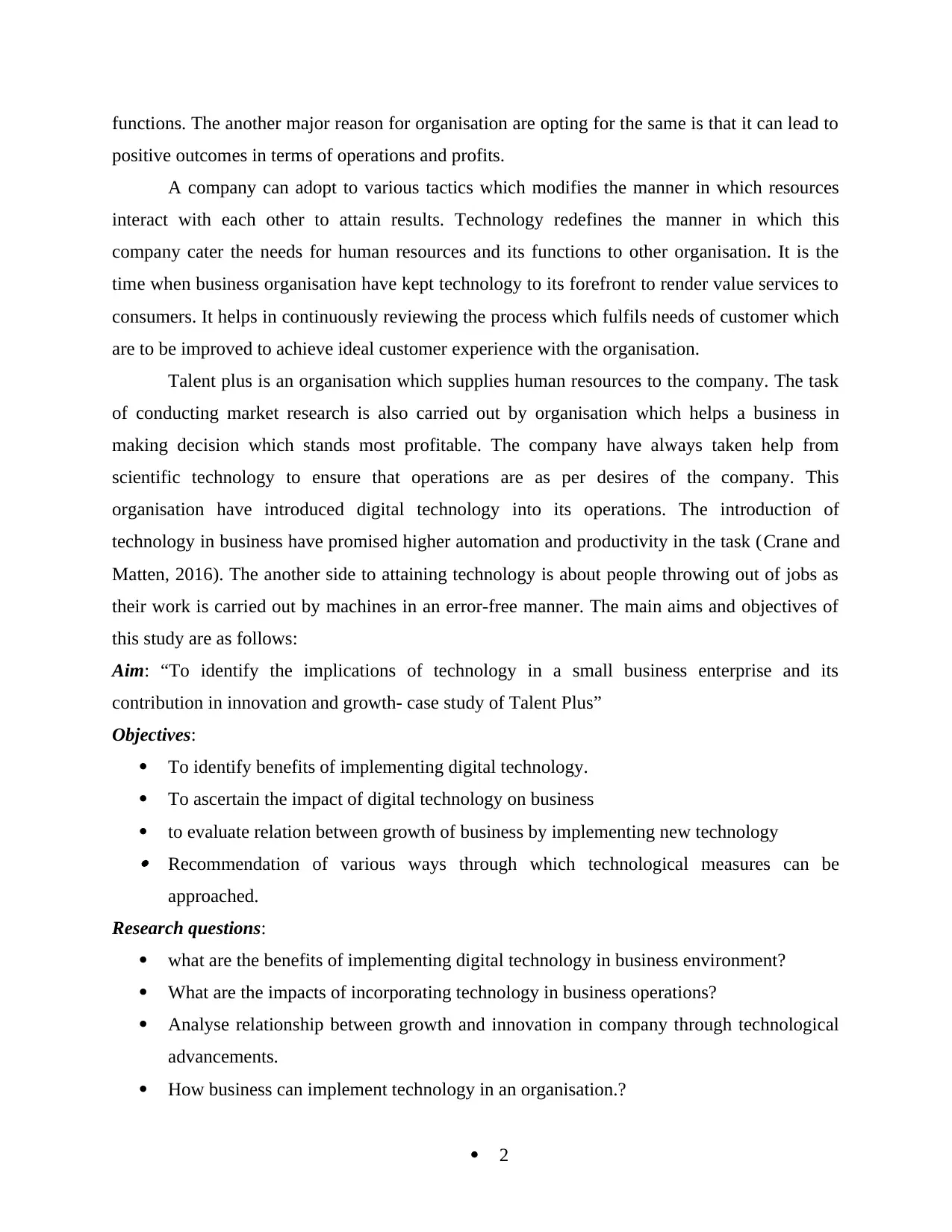
functions. The another major reason for organisation are opting for the same is that it can lead to
positive outcomes in terms of operations and profits.
A company can adopt to various tactics which modifies the manner in which resources
interact with each other to attain results. Technology redefines the manner in which this
company cater the needs for human resources and its functions to other organisation. It is the
time when business organisation have kept technology to its forefront to render value services to
consumers. It helps in continuously reviewing the process which fulfils needs of customer which
are to be improved to achieve ideal customer experience with the organisation.
Talent plus is an organisation which supplies human resources to the company. The task
of conducting market research is also carried out by organisation which helps a business in
making decision which stands most profitable. The company have always taken help from
scientific technology to ensure that operations are as per desires of the company. This
organisation have introduced digital technology into its operations. The introduction of
technology in business have promised higher automation and productivity in the task (Crane and
Matten, 2016). The another side to attaining technology is about people throwing out of jobs as
their work is carried out by machines in an error-free manner. The main aims and objectives of
this study are as follows:
Aim: “To identify the implications of technology in a small business enterprise and its
contribution in innovation and growth- case study of Talent Plus”
Objectives:
To identify benefits of implementing digital technology.
To ascertain the impact of digital technology on business
to evaluate relation between growth of business by implementing new technology Recommendation of various ways through which technological measures can be
approached.
Research questions:
what are the benefits of implementing digital technology in business environment?
What are the impacts of incorporating technology in business operations?
Analyse relationship between growth and innovation in company through technological
advancements.
How business can implement technology in an organisation.?
2
positive outcomes in terms of operations and profits.
A company can adopt to various tactics which modifies the manner in which resources
interact with each other to attain results. Technology redefines the manner in which this
company cater the needs for human resources and its functions to other organisation. It is the
time when business organisation have kept technology to its forefront to render value services to
consumers. It helps in continuously reviewing the process which fulfils needs of customer which
are to be improved to achieve ideal customer experience with the organisation.
Talent plus is an organisation which supplies human resources to the company. The task
of conducting market research is also carried out by organisation which helps a business in
making decision which stands most profitable. The company have always taken help from
scientific technology to ensure that operations are as per desires of the company. This
organisation have introduced digital technology into its operations. The introduction of
technology in business have promised higher automation and productivity in the task (Crane and
Matten, 2016). The another side to attaining technology is about people throwing out of jobs as
their work is carried out by machines in an error-free manner. The main aims and objectives of
this study are as follows:
Aim: “To identify the implications of technology in a small business enterprise and its
contribution in innovation and growth- case study of Talent Plus”
Objectives:
To identify benefits of implementing digital technology.
To ascertain the impact of digital technology on business
to evaluate relation between growth of business by implementing new technology Recommendation of various ways through which technological measures can be
approached.
Research questions:
what are the benefits of implementing digital technology in business environment?
What are the impacts of incorporating technology in business operations?
Analyse relationship between growth and innovation in company through technological
advancements.
How business can implement technology in an organisation.?
2
Secure Best Marks with AI Grader
Need help grading? Try our AI Grader for instant feedback on your assignments.
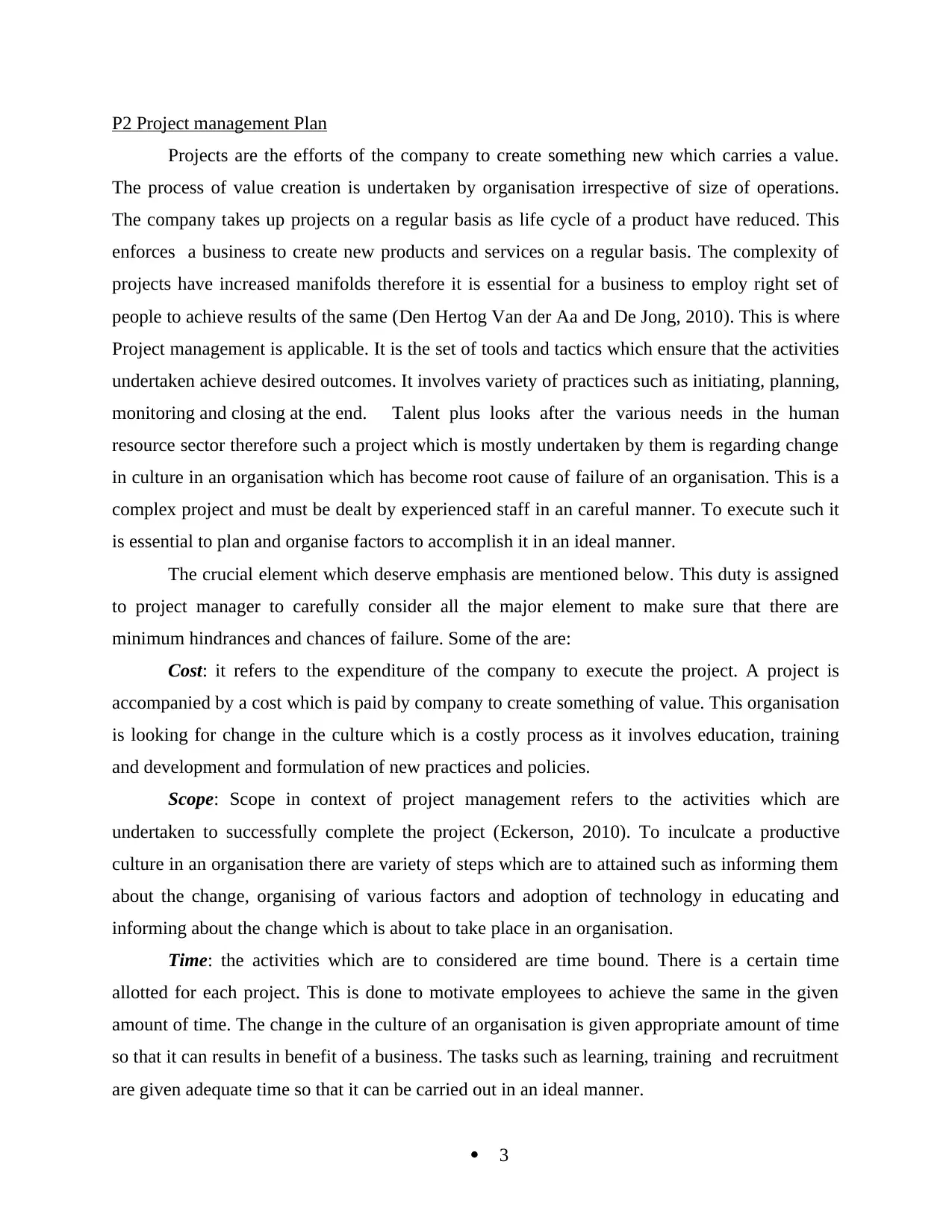
P2 Project management Plan
Projects are the efforts of the company to create something new which carries a value.
The process of value creation is undertaken by organisation irrespective of size of operations.
The company takes up projects on a regular basis as life cycle of a product have reduced. This
enforces a business to create new products and services on a regular basis. The complexity of
projects have increased manifolds therefore it is essential for a business to employ right set of
people to achieve results of the same (Den Hertog Van der Aa and De Jong, 2010). This is where
Project management is applicable. It is the set of tools and tactics which ensure that the activities
undertaken achieve desired outcomes. It involves variety of practices such as initiating, planning,
monitoring and closing at the end. Talent plus looks after the various needs in the human
resource sector therefore such a project which is mostly undertaken by them is regarding change
in culture in an organisation which has become root cause of failure of an organisation. This is a
complex project and must be dealt by experienced staff in an careful manner. To execute such it
is essential to plan and organise factors to accomplish it in an ideal manner.
The crucial element which deserve emphasis are mentioned below. This duty is assigned
to project manager to carefully consider all the major element to make sure that there are
minimum hindrances and chances of failure. Some of the are:
Cost: it refers to the expenditure of the company to execute the project. A project is
accompanied by a cost which is paid by company to create something of value. This organisation
is looking for change in the culture which is a costly process as it involves education, training
and development and formulation of new practices and policies.
Scope: Scope in context of project management refers to the activities which are
undertaken to successfully complete the project (Eckerson, 2010). To inculcate a productive
culture in an organisation there are variety of steps which are to attained such as informing them
about the change, organising of various factors and adoption of technology in educating and
informing about the change which is about to take place in an organisation.
Time: the activities which are to considered are time bound. There is a certain time
allotted for each project. This is done to motivate employees to achieve the same in the given
amount of time. The change in the culture of an organisation is given appropriate amount of time
so that it can results in benefit of a business. The tasks such as learning, training and recruitment
are given adequate time so that it can be carried out in an ideal manner.
3
Projects are the efforts of the company to create something new which carries a value.
The process of value creation is undertaken by organisation irrespective of size of operations.
The company takes up projects on a regular basis as life cycle of a product have reduced. This
enforces a business to create new products and services on a regular basis. The complexity of
projects have increased manifolds therefore it is essential for a business to employ right set of
people to achieve results of the same (Den Hertog Van der Aa and De Jong, 2010). This is where
Project management is applicable. It is the set of tools and tactics which ensure that the activities
undertaken achieve desired outcomes. It involves variety of practices such as initiating, planning,
monitoring and closing at the end. Talent plus looks after the various needs in the human
resource sector therefore such a project which is mostly undertaken by them is regarding change
in culture in an organisation which has become root cause of failure of an organisation. This is a
complex project and must be dealt by experienced staff in an careful manner. To execute such it
is essential to plan and organise factors to accomplish it in an ideal manner.
The crucial element which deserve emphasis are mentioned below. This duty is assigned
to project manager to carefully consider all the major element to make sure that there are
minimum hindrances and chances of failure. Some of the are:
Cost: it refers to the expenditure of the company to execute the project. A project is
accompanied by a cost which is paid by company to create something of value. This organisation
is looking for change in the culture which is a costly process as it involves education, training
and development and formulation of new practices and policies.
Scope: Scope in context of project management refers to the activities which are
undertaken to successfully complete the project (Eckerson, 2010). To inculcate a productive
culture in an organisation there are variety of steps which are to attained such as informing them
about the change, organising of various factors and adoption of technology in educating and
informing about the change which is about to take place in an organisation.
Time: the activities which are to considered are time bound. There is a certain time
allotted for each project. This is done to motivate employees to achieve the same in the given
amount of time. The change in the culture of an organisation is given appropriate amount of time
so that it can results in benefit of a business. The tasks such as learning, training and recruitment
are given adequate time so that it can be carried out in an ideal manner.
3

Risk: the change in culture which an organisation can undertake. The efforts are aimed to
inculcate new ways and means of accomplishing a task and elimination traditional methods of
task accomplishment. It is the biggest risk which an organisation can take as failed attempt in
this sector will disrupt the functioning of a business and will take time to attain a defined level of
certainty. The introduction of digital methods will help in better learning and training of
employees with the organisation to minimize risk to a lower level (Gebauer, Edvardsson and
Bjurko, 2010).
Communication: it is the most crucial element which is to be examined by a project
manager. There is a needs of an ideal communication channel which can help in providing
information and solving their queries. While trying to create a technology and performance
oriented environment it is essential for a business to emphasize on the communication pattern
adopted. The culture of an organisation cannot be transformed without opting for a suitable
communication tool. It can help in identifying problems which are being faced by employees and
try to resolve the same so that better performance can be attained.
Quality control: Maintaining quality is an important aspect of project management. All
the activities are carried out keeping in mind the quality which is to be provided to an
organisation (Incelli, 2013). Talent plus have to ensure that right set of workforce is provided to
organisation so that they are able to maintain their brand name. The changes in organisation
culture can only be attained when project manager manages to provide quality training and
learning platforms to the same so that project's quality can be maintained.
The manager responsible for the project have to identify and examine these factors in an
ideal manner so that project can be planned and executed in an desired manner (Jones, G. and
Lubinski, 2012.). The project should carry minimum amount of risk which paying special
emphasis to quality delivered to other party.
P3 Work breakdown structure and Gantt chart
These are the major tool which are incorporated by a business in planning a project. It is
known that a project is an complex system which needs to be broken down into various
components which are time bound. This is done to allocate ideal time to all activities which are
essential to accomplish project in the manner defined.
Work Breakdown structure
4
inculcate new ways and means of accomplishing a task and elimination traditional methods of
task accomplishment. It is the biggest risk which an organisation can take as failed attempt in
this sector will disrupt the functioning of a business and will take time to attain a defined level of
certainty. The introduction of digital methods will help in better learning and training of
employees with the organisation to minimize risk to a lower level (Gebauer, Edvardsson and
Bjurko, 2010).
Communication: it is the most crucial element which is to be examined by a project
manager. There is a needs of an ideal communication channel which can help in providing
information and solving their queries. While trying to create a technology and performance
oriented environment it is essential for a business to emphasize on the communication pattern
adopted. The culture of an organisation cannot be transformed without opting for a suitable
communication tool. It can help in identifying problems which are being faced by employees and
try to resolve the same so that better performance can be attained.
Quality control: Maintaining quality is an important aspect of project management. All
the activities are carried out keeping in mind the quality which is to be provided to an
organisation (Incelli, 2013). Talent plus have to ensure that right set of workforce is provided to
organisation so that they are able to maintain their brand name. The changes in organisation
culture can only be attained when project manager manages to provide quality training and
learning platforms to the same so that project's quality can be maintained.
The manager responsible for the project have to identify and examine these factors in an
ideal manner so that project can be planned and executed in an desired manner (Jones, G. and
Lubinski, 2012.). The project should carry minimum amount of risk which paying special
emphasis to quality delivered to other party.
P3 Work breakdown structure and Gantt chart
These are the major tool which are incorporated by a business in planning a project. It is
known that a project is an complex system which needs to be broken down into various
components which are time bound. This is done to allocate ideal time to all activities which are
essential to accomplish project in the manner defined.
Work Breakdown structure
4

As the name suggests, work breakdown structure aims to braking down a project into
smaller element so that they are managed effectively. This is done so that every activity is
completed with appropriate time and resources which leads to ideal completion of project. The
hierarchical division of activities can be managed and monitored effectively rather than
supervising a whole project (Kankaanranta and Planken, 2010). The change in the culture which
is undertaken by cited organisation will be categorised on the grounds of education, training,
development activities to develop a culture which is performance oriented. This is done so that
an organisation can compete in the market in a better manner. This management consulting
agency helps in catering the needs of mega organisation in domain of human resources. Talent
plus have formed a separate division who is responsible for successful completion of projects.
The decomposition of work is undertaken in project and smaller elements are formed so that they
are deliverable to the organisation.
Il
lustration 1: Work Breakdown structure
(Source: Work Breakdown structure, 2016)
Gantt chart
The activities which were broken down to smaller components are now allotted with time
under which they are to be achieved. This tool with the help of graphical representation can
depict the amount of work completed in a project. The tool formulated by Henry Gantt in context
of project management. This chart also shows time, resources and progress which has been
carried out in process (Lai and Ong, 2010). In domain of project management, this tool have
garnered worldwide appreciation. It is very important to look after each and every segment of
project to prevent it from getting failed. This tool is utilised in planning and scheduling of
5
smaller element so that they are managed effectively. This is done so that every activity is
completed with appropriate time and resources which leads to ideal completion of project. The
hierarchical division of activities can be managed and monitored effectively rather than
supervising a whole project (Kankaanranta and Planken, 2010). The change in the culture which
is undertaken by cited organisation will be categorised on the grounds of education, training,
development activities to develop a culture which is performance oriented. This is done so that
an organisation can compete in the market in a better manner. This management consulting
agency helps in catering the needs of mega organisation in domain of human resources. Talent
plus have formed a separate division who is responsible for successful completion of projects.
The decomposition of work is undertaken in project and smaller elements are formed so that they
are deliverable to the organisation.
Il
lustration 1: Work Breakdown structure
(Source: Work Breakdown structure, 2016)
Gantt chart
The activities which were broken down to smaller components are now allotted with time
under which they are to be achieved. This tool with the help of graphical representation can
depict the amount of work completed in a project. The tool formulated by Henry Gantt in context
of project management. This chart also shows time, resources and progress which has been
carried out in process (Lai and Ong, 2010). In domain of project management, this tool have
garnered worldwide appreciation. It is very important to look after each and every segment of
project to prevent it from getting failed. This tool is utilised in planning and scheduling of
5
Paraphrase This Document
Need a fresh take? Get an instant paraphrase of this document with our AI Paraphraser
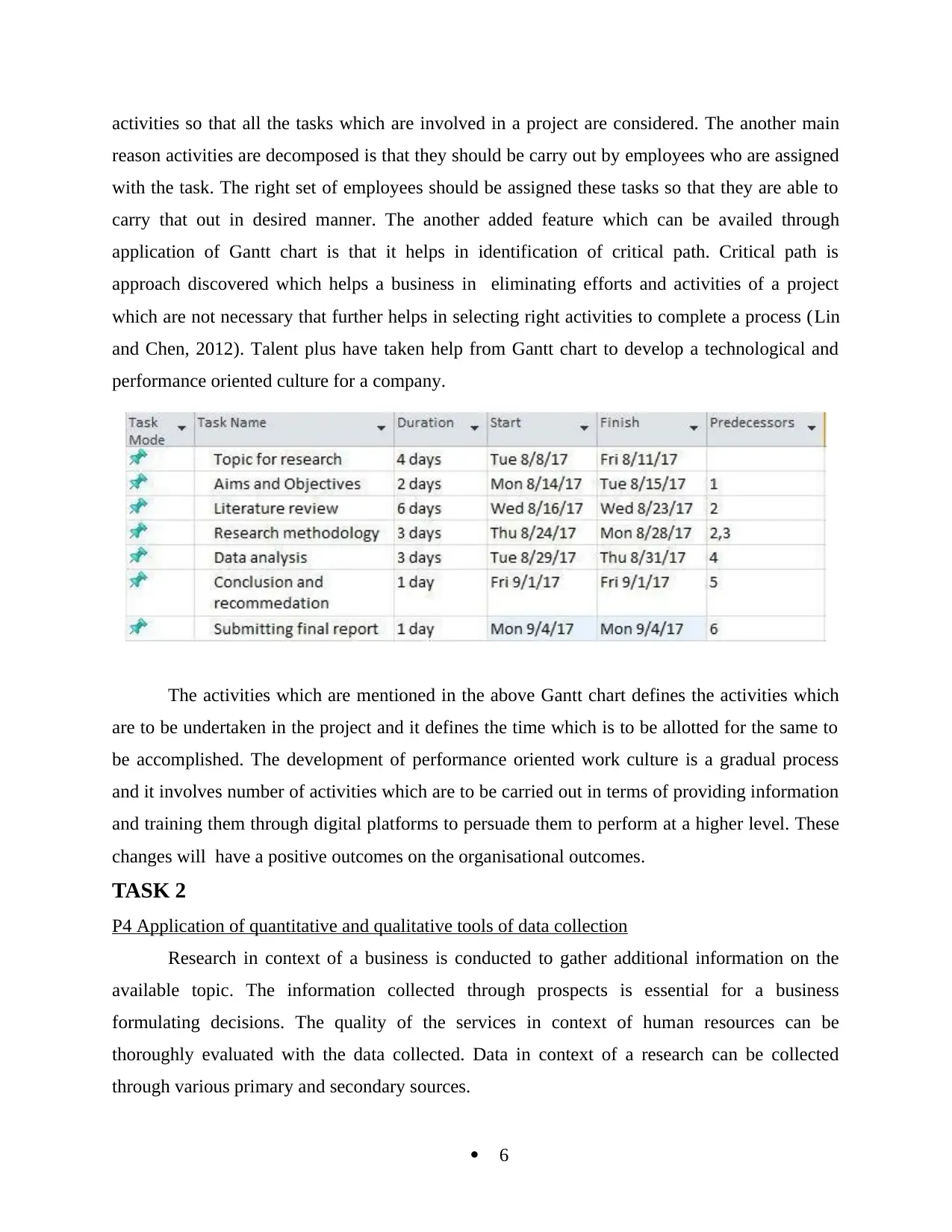
activities so that all the tasks which are involved in a project are considered. The another main
reason activities are decomposed is that they should be carry out by employees who are assigned
with the task. The right set of employees should be assigned these tasks so that they are able to
carry that out in desired manner. The another added feature which can be availed through
application of Gantt chart is that it helps in identification of critical path. Critical path is
approach discovered which helps a business in eliminating efforts and activities of a project
which are not necessary that further helps in selecting right activities to complete a process (Lin
and Chen, 2012). Talent plus have taken help from Gantt chart to develop a technological and
performance oriented culture for a company.
The activities which are mentioned in the above Gantt chart defines the activities which
are to be undertaken in the project and it defines the time which is to be allotted for the same to
be accomplished. The development of performance oriented work culture is a gradual process
and it involves number of activities which are to be carried out in terms of providing information
and training them through digital platforms to persuade them to perform at a higher level. These
changes will have a positive outcomes on the organisational outcomes.
TASK 2
P4 Application of quantitative and qualitative tools of data collection
Research in context of a business is conducted to gather additional information on the
available topic. The information collected through prospects is essential for a business
formulating decisions. The quality of the services in context of human resources can be
thoroughly evaluated with the data collected. Data in context of a research can be collected
through various primary and secondary sources.
6
reason activities are decomposed is that they should be carry out by employees who are assigned
with the task. The right set of employees should be assigned these tasks so that they are able to
carry that out in desired manner. The another added feature which can be availed through
application of Gantt chart is that it helps in identification of critical path. Critical path is
approach discovered which helps a business in eliminating efforts and activities of a project
which are not necessary that further helps in selecting right activities to complete a process (Lin
and Chen, 2012). Talent plus have taken help from Gantt chart to develop a technological and
performance oriented culture for a company.
The activities which are mentioned in the above Gantt chart defines the activities which
are to be undertaken in the project and it defines the time which is to be allotted for the same to
be accomplished. The development of performance oriented work culture is a gradual process
and it involves number of activities which are to be carried out in terms of providing information
and training them through digital platforms to persuade them to perform at a higher level. These
changes will have a positive outcomes on the organisational outcomes.
TASK 2
P4 Application of quantitative and qualitative tools of data collection
Research in context of a business is conducted to gather additional information on the
available topic. The information collected through prospects is essential for a business
formulating decisions. The quality of the services in context of human resources can be
thoroughly evaluated with the data collected. Data in context of a research can be collected
through various primary and secondary sources.
6
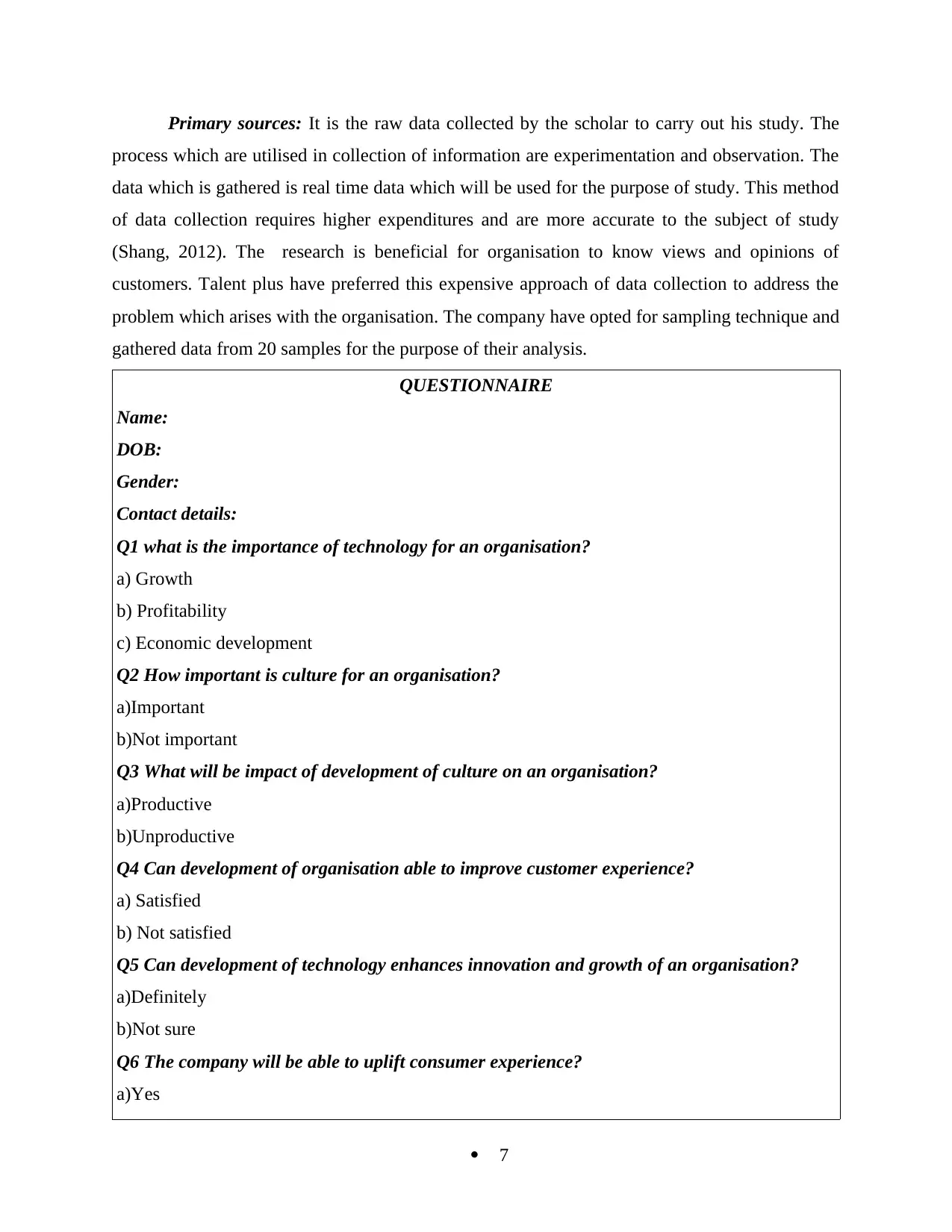
Primary sources: It is the raw data collected by the scholar to carry out his study. The
process which are utilised in collection of information are experimentation and observation. The
data which is gathered is real time data which will be used for the purpose of study. This method
of data collection requires higher expenditures and are more accurate to the subject of study
(Shang, 2012). The research is beneficial for organisation to know views and opinions of
customers. Talent plus have preferred this expensive approach of data collection to address the
problem which arises with the organisation. The company have opted for sampling technique and
gathered data from 20 samples for the purpose of their analysis.
QUESTIONNAIRE
Name:
DOB:
Gender:
Contact details:
Q1 what is the importance of technology for an organisation?
a) Growth
b) Profitability
c) Economic development
Q2 How important is culture for an organisation?
a)Important
b)Not important
Q3 What will be impact of development of culture on an organisation?
a)Productive
b)Unproductive
Q4 Can development of organisation able to improve customer experience?
a) Satisfied
b) Not satisfied
Q5 Can development of technology enhances innovation and growth of an organisation?
a)Definitely
b)Not sure
Q6 The company will be able to uplift consumer experience?
a)Yes
7
process which are utilised in collection of information are experimentation and observation. The
data which is gathered is real time data which will be used for the purpose of study. This method
of data collection requires higher expenditures and are more accurate to the subject of study
(Shang, 2012). The research is beneficial for organisation to know views and opinions of
customers. Talent plus have preferred this expensive approach of data collection to address the
problem which arises with the organisation. The company have opted for sampling technique and
gathered data from 20 samples for the purpose of their analysis.
QUESTIONNAIRE
Name:
DOB:
Gender:
Contact details:
Q1 what is the importance of technology for an organisation?
a) Growth
b) Profitability
c) Economic development
Q2 How important is culture for an organisation?
a)Important
b)Not important
Q3 What will be impact of development of culture on an organisation?
a)Productive
b)Unproductive
Q4 Can development of organisation able to improve customer experience?
a) Satisfied
b) Not satisfied
Q5 Can development of technology enhances innovation and growth of an organisation?
a)Definitely
b)Not sure
Q6 The company will be able to uplift consumer experience?
a)Yes
7
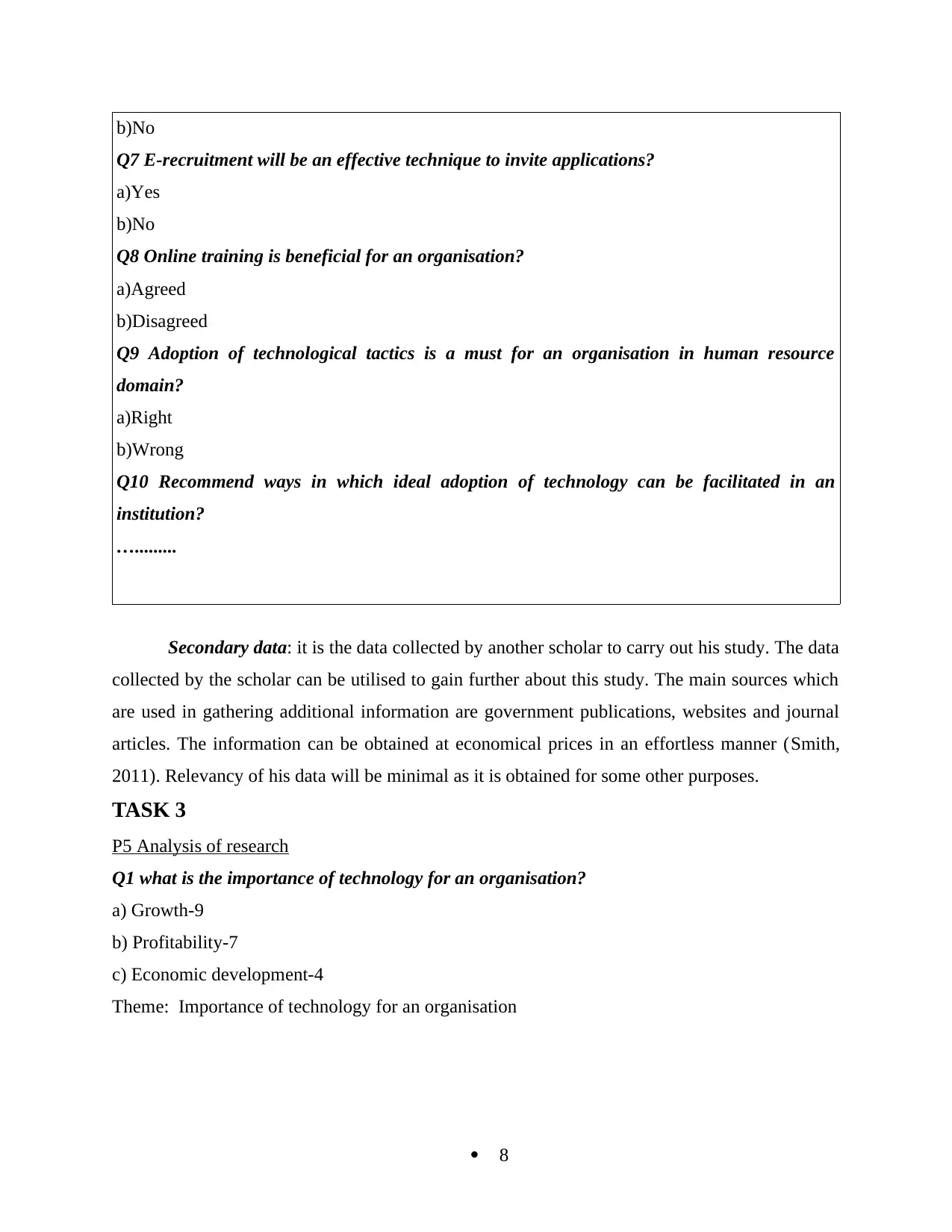
b)No
Q7 E-recruitment will be an effective technique to invite applications?
a)Yes
b)No
Q8 Online training is beneficial for an organisation?
a)Agreed
b)Disagreed
Q9 Adoption of technological tactics is a must for an organisation in human resource
domain?
a)Right
b)Wrong
Q10 Recommend ways in which ideal adoption of technology can be facilitated in an
institution?
….........
Secondary data: it is the data collected by another scholar to carry out his study. The data
collected by the scholar can be utilised to gain further about this study. The main sources which
are used in gathering additional information are government publications, websites and journal
articles. The information can be obtained at economical prices in an effortless manner (Smith,
2011). Relevancy of his data will be minimal as it is obtained for some other purposes.
TASK 3
P5 Analysis of research
Q1 what is the importance of technology for an organisation?
a) Growth-9
b) Profitability-7
c) Economic development-4
Theme: Importance of technology for an organisation
8
Q7 E-recruitment will be an effective technique to invite applications?
a)Yes
b)No
Q8 Online training is beneficial for an organisation?
a)Agreed
b)Disagreed
Q9 Adoption of technological tactics is a must for an organisation in human resource
domain?
a)Right
b)Wrong
Q10 Recommend ways in which ideal adoption of technology can be facilitated in an
institution?
….........
Secondary data: it is the data collected by another scholar to carry out his study. The data
collected by the scholar can be utilised to gain further about this study. The main sources which
are used in gathering additional information are government publications, websites and journal
articles. The information can be obtained at economical prices in an effortless manner (Smith,
2011). Relevancy of his data will be minimal as it is obtained for some other purposes.
TASK 3
P5 Analysis of research
Q1 what is the importance of technology for an organisation?
a) Growth-9
b) Profitability-7
c) Economic development-4
Theme: Importance of technology for an organisation
8
Secure Best Marks with AI Grader
Need help grading? Try our AI Grader for instant feedback on your assignments.
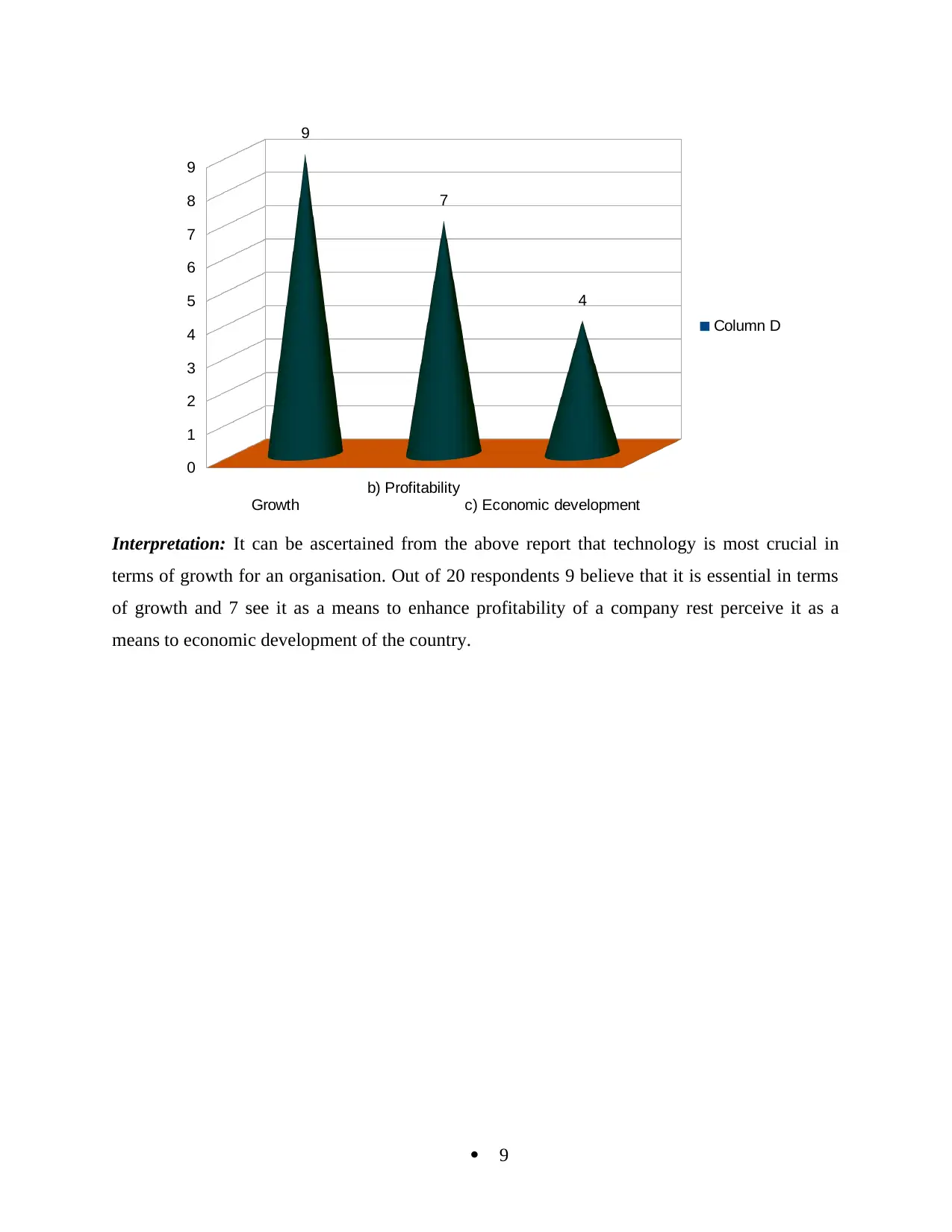
Interpretation: It can be ascertained from the above report that technology is most crucial in
terms of growth for an organisation. Out of 20 respondents 9 believe that it is essential in terms
of growth and 7 see it as a means to enhance profitability of a company rest perceive it as a
means to economic development of the country.
9
Growth
b) Profitability
c) Economic development
0
1
2
3
4
5
6
7
8
9
9
7
4
Column D
terms of growth for an organisation. Out of 20 respondents 9 believe that it is essential in terms
of growth and 7 see it as a means to enhance profitability of a company rest perceive it as a
means to economic development of the country.
9
Growth
b) Profitability
c) Economic development
0
1
2
3
4
5
6
7
8
9
9
7
4
Column D
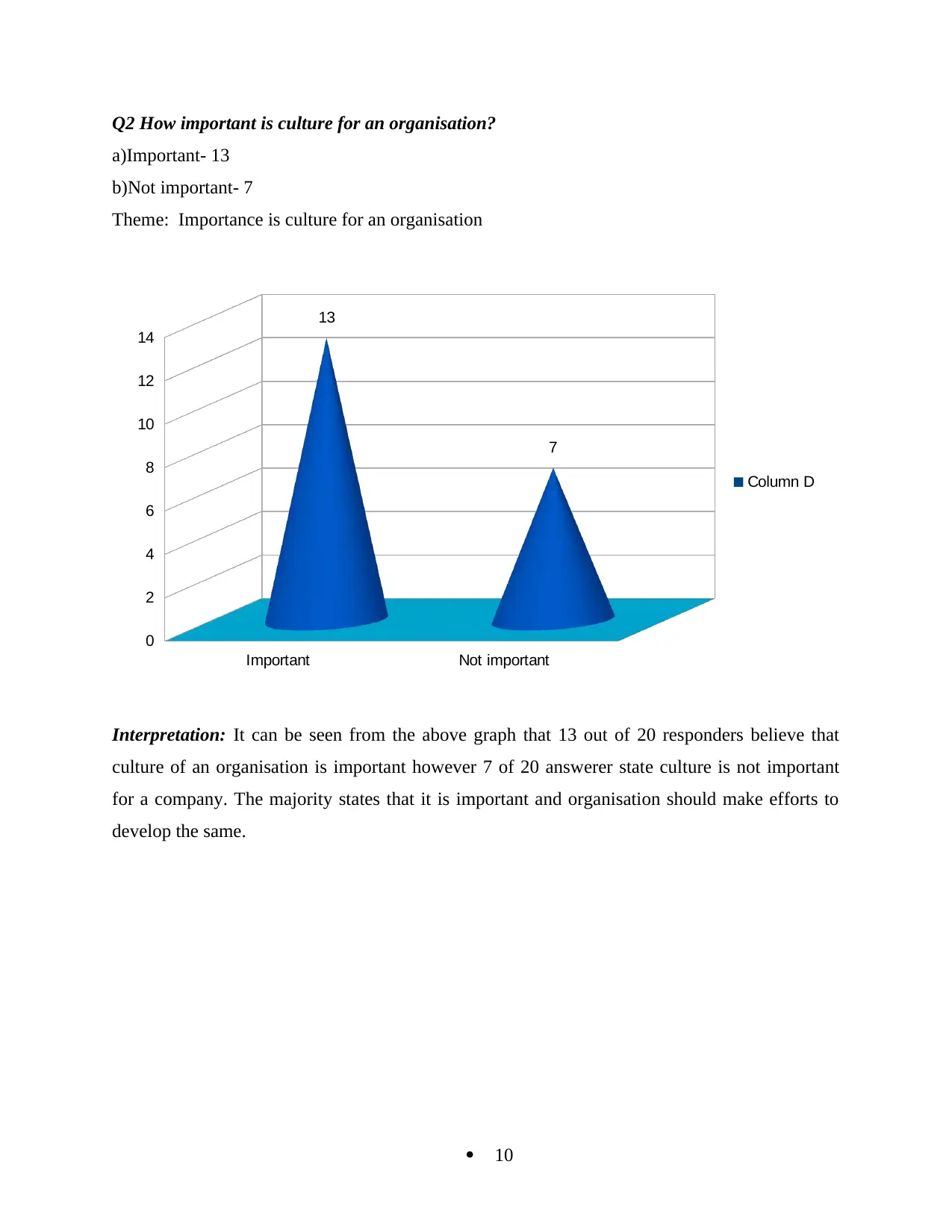
Q2 How important is culture for an organisation?
a)Important- 13
b)Not important- 7
Theme: Importance is culture for an organisation
Interpretation: It can be seen from the above graph that 13 out of 20 responders believe that
culture of an organisation is important however 7 of 20 answerer state culture is not important
for a company. The majority states that it is important and organisation should make efforts to
develop the same.
10
Important Not important
0
2
4
6
8
10
12
14
13
7
Column D
a)Important- 13
b)Not important- 7
Theme: Importance is culture for an organisation
Interpretation: It can be seen from the above graph that 13 out of 20 responders believe that
culture of an organisation is important however 7 of 20 answerer state culture is not important
for a company. The majority states that it is important and organisation should make efforts to
develop the same.
10
Important Not important
0
2
4
6
8
10
12
14
13
7
Column D
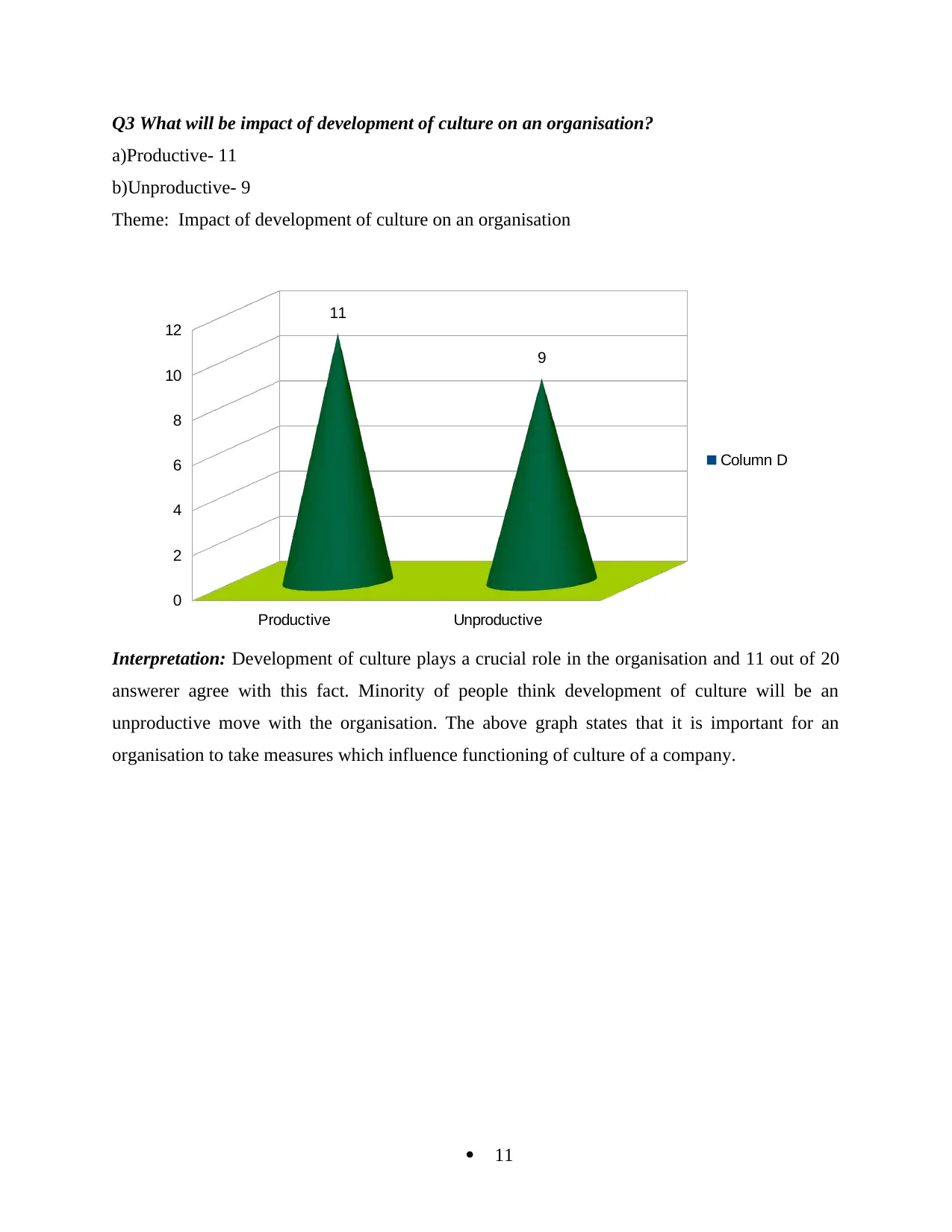
Q3 What will be impact of development of culture on an organisation?
a)Productive- 11
b)Unproductive- 9
Theme: Impact of development of culture on an organisation
Interpretation: Development of culture plays a crucial role in the organisation and 11 out of 20
answerer agree with this fact. Minority of people think development of culture will be an
unproductive move with the organisation. The above graph states that it is important for an
organisation to take measures which influence functioning of culture of a company.
11
Productive Unproductive
0
2
4
6
8
10
12
11
9
Column D
a)Productive- 11
b)Unproductive- 9
Theme: Impact of development of culture on an organisation
Interpretation: Development of culture plays a crucial role in the organisation and 11 out of 20
answerer agree with this fact. Minority of people think development of culture will be an
unproductive move with the organisation. The above graph states that it is important for an
organisation to take measures which influence functioning of culture of a company.
11
Productive Unproductive
0
2
4
6
8
10
12
11
9
Column D
Paraphrase This Document
Need a fresh take? Get an instant paraphrase of this document with our AI Paraphraser
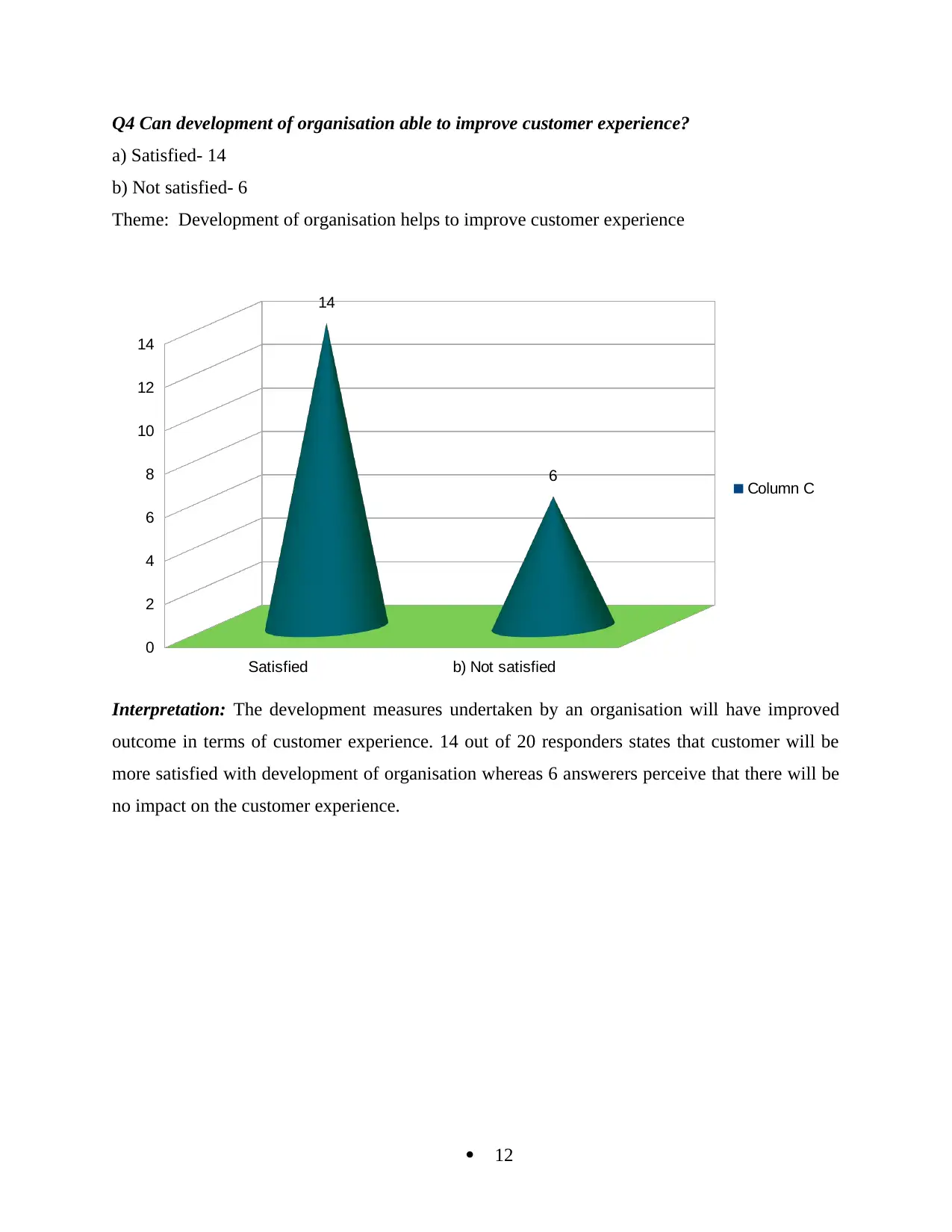
Q4 Can development of organisation able to improve customer experience?
a) Satisfied- 14
b) Not satisfied- 6
Theme: Development of organisation helps to improve customer experience
Interpretation: The development measures undertaken by an organisation will have improved
outcome in terms of customer experience. 14 out of 20 responders states that customer will be
more satisfied with development of organisation whereas 6 answerers perceive that there will be
no impact on the customer experience.
12
Satisfied b) Not satisfied
0
2
4
6
8
10
12
14
14
6 Column C
a) Satisfied- 14
b) Not satisfied- 6
Theme: Development of organisation helps to improve customer experience
Interpretation: The development measures undertaken by an organisation will have improved
outcome in terms of customer experience. 14 out of 20 responders states that customer will be
more satisfied with development of organisation whereas 6 answerers perceive that there will be
no impact on the customer experience.
12
Satisfied b) Not satisfied
0
2
4
6
8
10
12
14
14
6 Column C
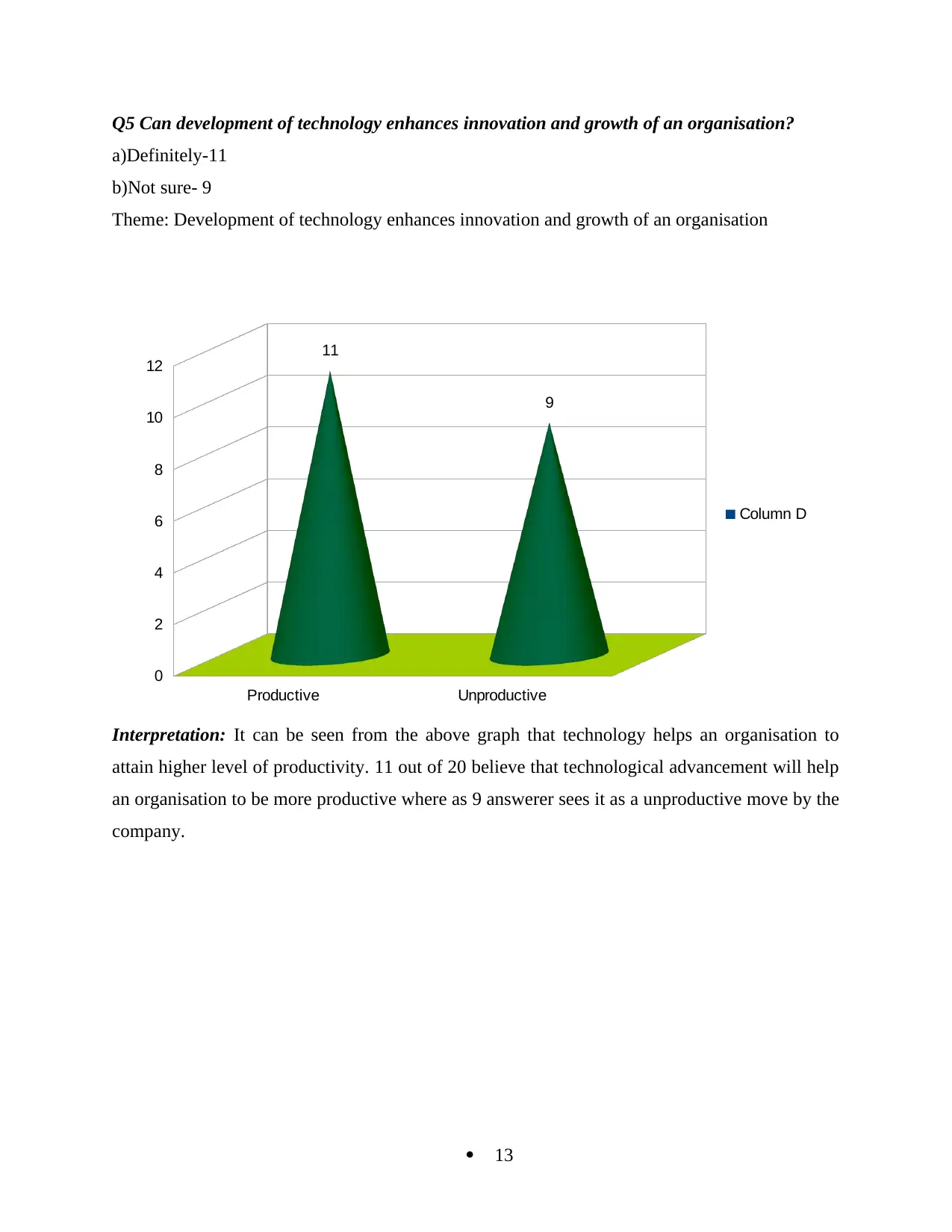
Q5 Can development of technology enhances innovation and growth of an organisation?
a)Definitely-11
b)Not sure- 9
Theme: Development of technology enhances innovation and growth of an organisation
Interpretation: It can be seen from the above graph that technology helps an organisation to
attain higher level of productivity. 11 out of 20 believe that technological advancement will help
an organisation to be more productive where as 9 answerer sees it as a unproductive move by the
company.
13
Productive Unproductive
0
2
4
6
8
10
12
11
9
Column D
a)Definitely-11
b)Not sure- 9
Theme: Development of technology enhances innovation and growth of an organisation
Interpretation: It can be seen from the above graph that technology helps an organisation to
attain higher level of productivity. 11 out of 20 believe that technological advancement will help
an organisation to be more productive where as 9 answerer sees it as a unproductive move by the
company.
13
Productive Unproductive
0
2
4
6
8
10
12
11
9
Column D
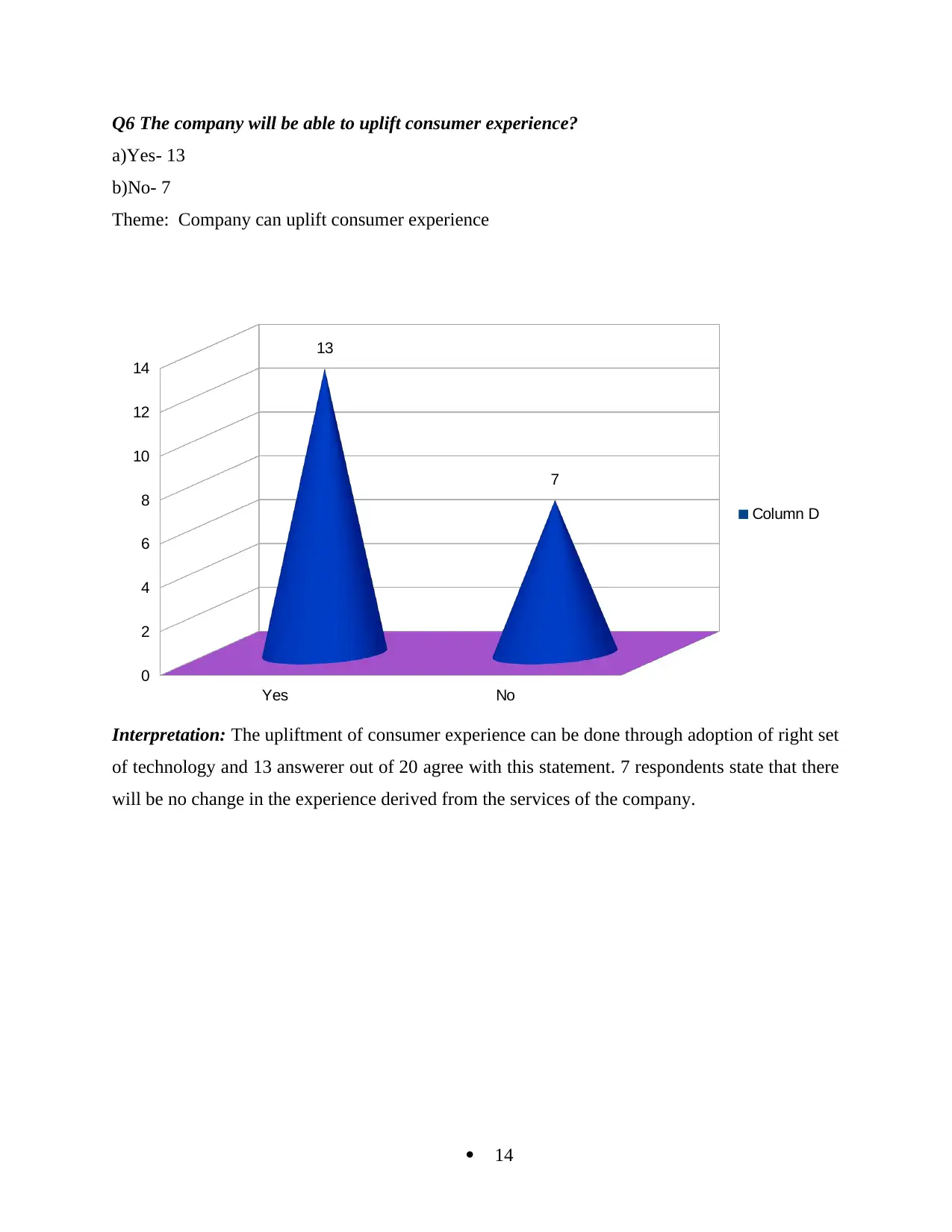
Q6 The company will be able to uplift consumer experience?
a)Yes- 13
b)No- 7
Theme: Company can uplift consumer experience
Interpretation: The upliftment of consumer experience can be done through adoption of right set
of technology and 13 answerer out of 20 agree with this statement. 7 respondents state that there
will be no change in the experience derived from the services of the company.
14
Yes No
0
2
4
6
8
10
12
14
13
7
Column D
a)Yes- 13
b)No- 7
Theme: Company can uplift consumer experience
Interpretation: The upliftment of consumer experience can be done through adoption of right set
of technology and 13 answerer out of 20 agree with this statement. 7 respondents state that there
will be no change in the experience derived from the services of the company.
14
Yes No
0
2
4
6
8
10
12
14
13
7
Column D
Secure Best Marks with AI Grader
Need help grading? Try our AI Grader for instant feedback on your assignments.
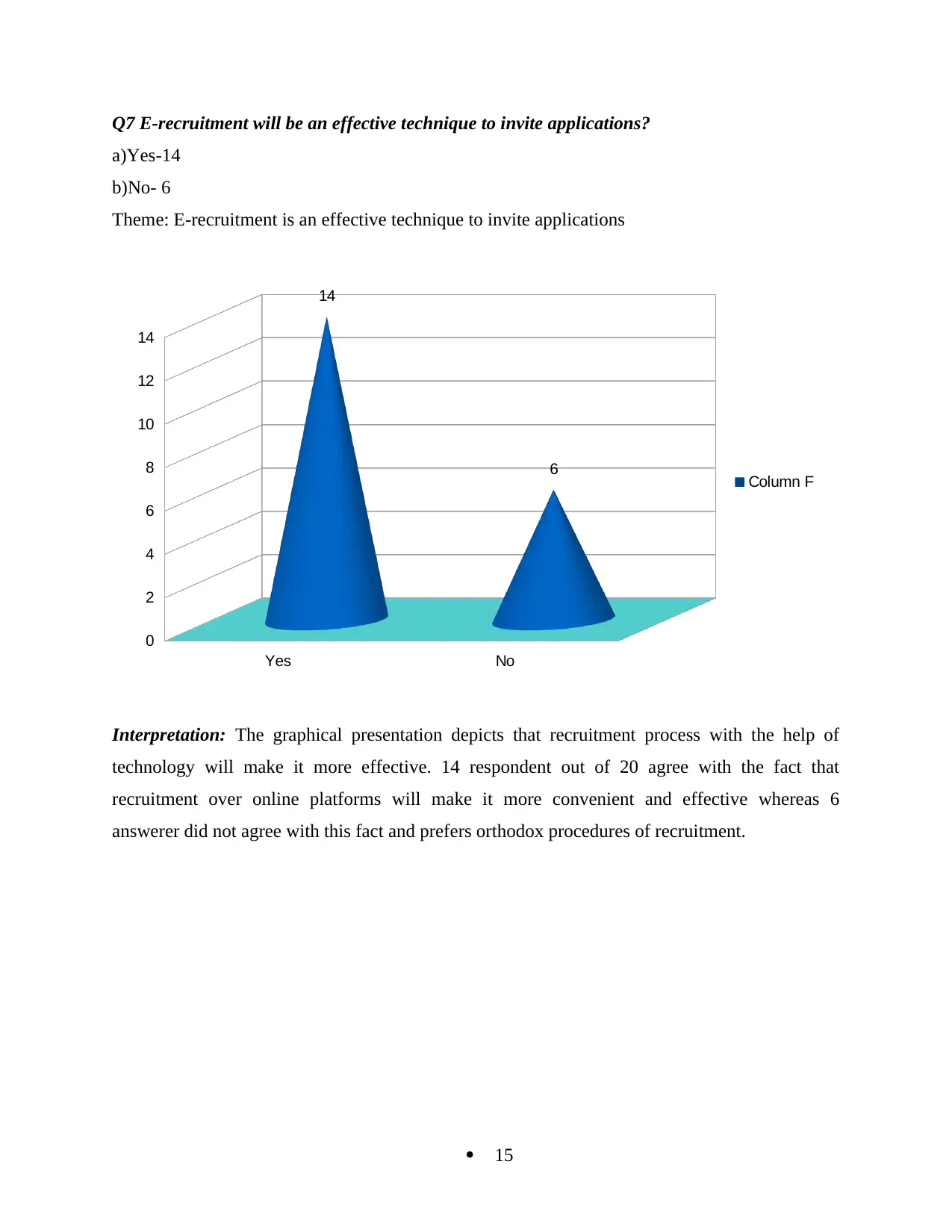
Q7 E-recruitment will be an effective technique to invite applications?
a)Yes-14
b)No- 6
Theme: E-recruitment is an effective technique to invite applications
Interpretation: The graphical presentation depicts that recruitment process with the help of
technology will make it more effective. 14 respondent out of 20 agree with the fact that
recruitment over online platforms will make it more convenient and effective whereas 6
answerer did not agree with this fact and prefers orthodox procedures of recruitment.
15
Yes No
0
2
4
6
8
10
12
14
14
6 Column F
a)Yes-14
b)No- 6
Theme: E-recruitment is an effective technique to invite applications
Interpretation: The graphical presentation depicts that recruitment process with the help of
technology will make it more effective. 14 respondent out of 20 agree with the fact that
recruitment over online platforms will make it more convenient and effective whereas 6
answerer did not agree with this fact and prefers orthodox procedures of recruitment.
15
Yes No
0
2
4
6
8
10
12
14
14
6 Column F

Q8 Online training is beneficial for an organisation?
a)Agreed- 9
b)Disagreed- 11
Theme: Online training is beneficial for an organisation
Interpretation: Training are the measure through which skills and capabilities of an employee
can be improved. The majority of respondents believe that inculcation of technology will not be
able to attain same results. They prefers the traditional tools of training such as mentoring and
supervision. 9 out of 20 agree with the statement that online training is beneficial for an
organisation.
16
Agreed Disagreed
0
2
4
6
8
10
12
9
11
Column F
a)Agreed- 9
b)Disagreed- 11
Theme: Online training is beneficial for an organisation
Interpretation: Training are the measure through which skills and capabilities of an employee
can be improved. The majority of respondents believe that inculcation of technology will not be
able to attain same results. They prefers the traditional tools of training such as mentoring and
supervision. 9 out of 20 agree with the statement that online training is beneficial for an
organisation.
16
Agreed Disagreed
0
2
4
6
8
10
12
9
11
Column F
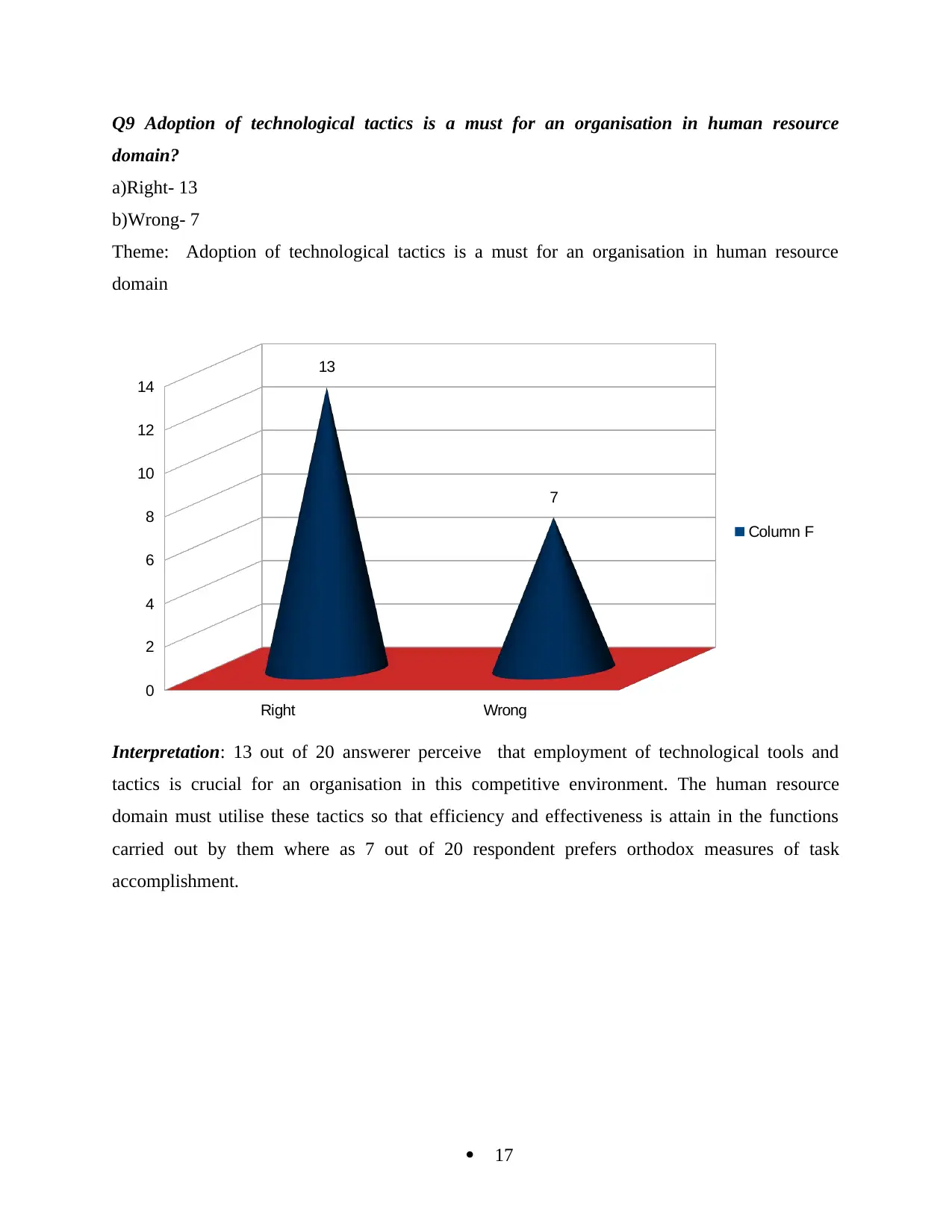
Q9 Adoption of technological tactics is a must for an organisation in human resource
domain?
a)Right- 13
b)Wrong- 7
Theme: Adoption of technological tactics is a must for an organisation in human resource
domain
Interpretation: 13 out of 20 answerer perceive that employment of technological tools and
tactics is crucial for an organisation in this competitive environment. The human resource
domain must utilise these tactics so that efficiency and effectiveness is attain in the functions
carried out by them where as 7 out of 20 respondent prefers orthodox measures of task
accomplishment.
17
Right Wrong
0
2
4
6
8
10
12
14
13
7
Column F
domain?
a)Right- 13
b)Wrong- 7
Theme: Adoption of technological tactics is a must for an organisation in human resource
domain
Interpretation: 13 out of 20 answerer perceive that employment of technological tools and
tactics is crucial for an organisation in this competitive environment. The human resource
domain must utilise these tactics so that efficiency and effectiveness is attain in the functions
carried out by them where as 7 out of 20 respondent prefers orthodox measures of task
accomplishment.
17
Right Wrong
0
2
4
6
8
10
12
14
13
7
Column F
Paraphrase This Document
Need a fresh take? Get an instant paraphrase of this document with our AI Paraphraser
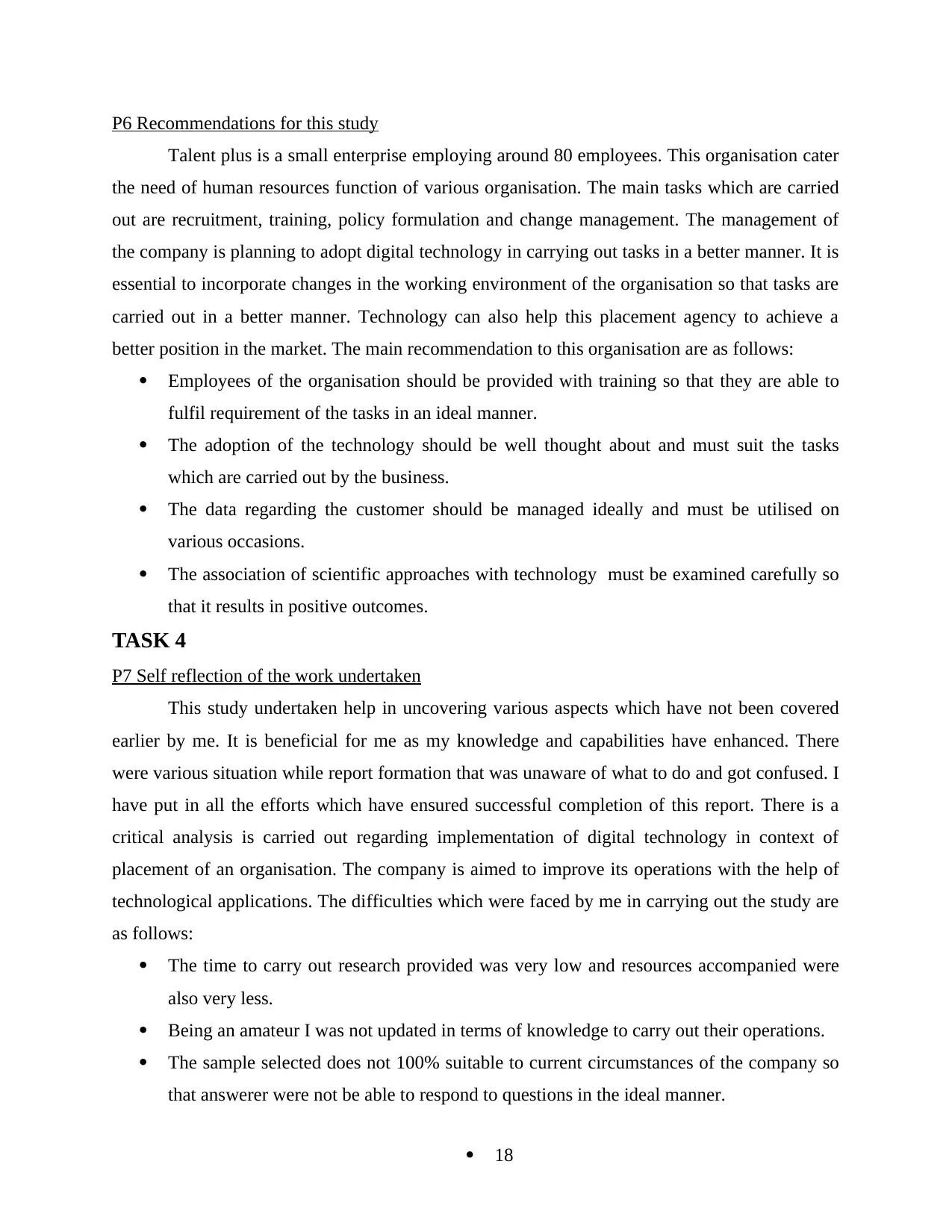
P6 Recommendations for this study
Talent plus is a small enterprise employing around 80 employees. This organisation cater
the need of human resources function of various organisation. The main tasks which are carried
out are recruitment, training, policy formulation and change management. The management of
the company is planning to adopt digital technology in carrying out tasks in a better manner. It is
essential to incorporate changes in the working environment of the organisation so that tasks are
carried out in a better manner. Technology can also help this placement agency to achieve a
better position in the market. The main recommendation to this organisation are as follows:
Employees of the organisation should be provided with training so that they are able to
fulfil requirement of the tasks in an ideal manner.
The adoption of the technology should be well thought about and must suit the tasks
which are carried out by the business.
The data regarding the customer should be managed ideally and must be utilised on
various occasions.
The association of scientific approaches with technology must be examined carefully so
that it results in positive outcomes.
TASK 4
P7 Self reflection of the work undertaken
This study undertaken help in uncovering various aspects which have not been covered
earlier by me. It is beneficial for me as my knowledge and capabilities have enhanced. There
were various situation while report formation that was unaware of what to do and got confused. I
have put in all the efforts which have ensured successful completion of this report. There is a
critical analysis is carried out regarding implementation of digital technology in context of
placement of an organisation. The company is aimed to improve its operations with the help of
technological applications. The difficulties which were faced by me in carrying out the study are
as follows:
The time to carry out research provided was very low and resources accompanied were
also very less.
Being an amateur I was not updated in terms of knowledge to carry out their operations.
The sample selected does not 100% suitable to current circumstances of the company so
that answerer were not be able to respond to questions in the ideal manner.
18
Talent plus is a small enterprise employing around 80 employees. This organisation cater
the need of human resources function of various organisation. The main tasks which are carried
out are recruitment, training, policy formulation and change management. The management of
the company is planning to adopt digital technology in carrying out tasks in a better manner. It is
essential to incorporate changes in the working environment of the organisation so that tasks are
carried out in a better manner. Technology can also help this placement agency to achieve a
better position in the market. The main recommendation to this organisation are as follows:
Employees of the organisation should be provided with training so that they are able to
fulfil requirement of the tasks in an ideal manner.
The adoption of the technology should be well thought about and must suit the tasks
which are carried out by the business.
The data regarding the customer should be managed ideally and must be utilised on
various occasions.
The association of scientific approaches with technology must be examined carefully so
that it results in positive outcomes.
TASK 4
P7 Self reflection of the work undertaken
This study undertaken help in uncovering various aspects which have not been covered
earlier by me. It is beneficial for me as my knowledge and capabilities have enhanced. There
were various situation while report formation that was unaware of what to do and got confused. I
have put in all the efforts which have ensured successful completion of this report. There is a
critical analysis is carried out regarding implementation of digital technology in context of
placement of an organisation. The company is aimed to improve its operations with the help of
technological applications. The difficulties which were faced by me in carrying out the study are
as follows:
The time to carry out research provided was very low and resources accompanied were
also very less.
Being an amateur I was not updated in terms of knowledge to carry out their operations.
The sample selected does not 100% suitable to current circumstances of the company so
that answerer were not be able to respond to questions in the ideal manner.
18
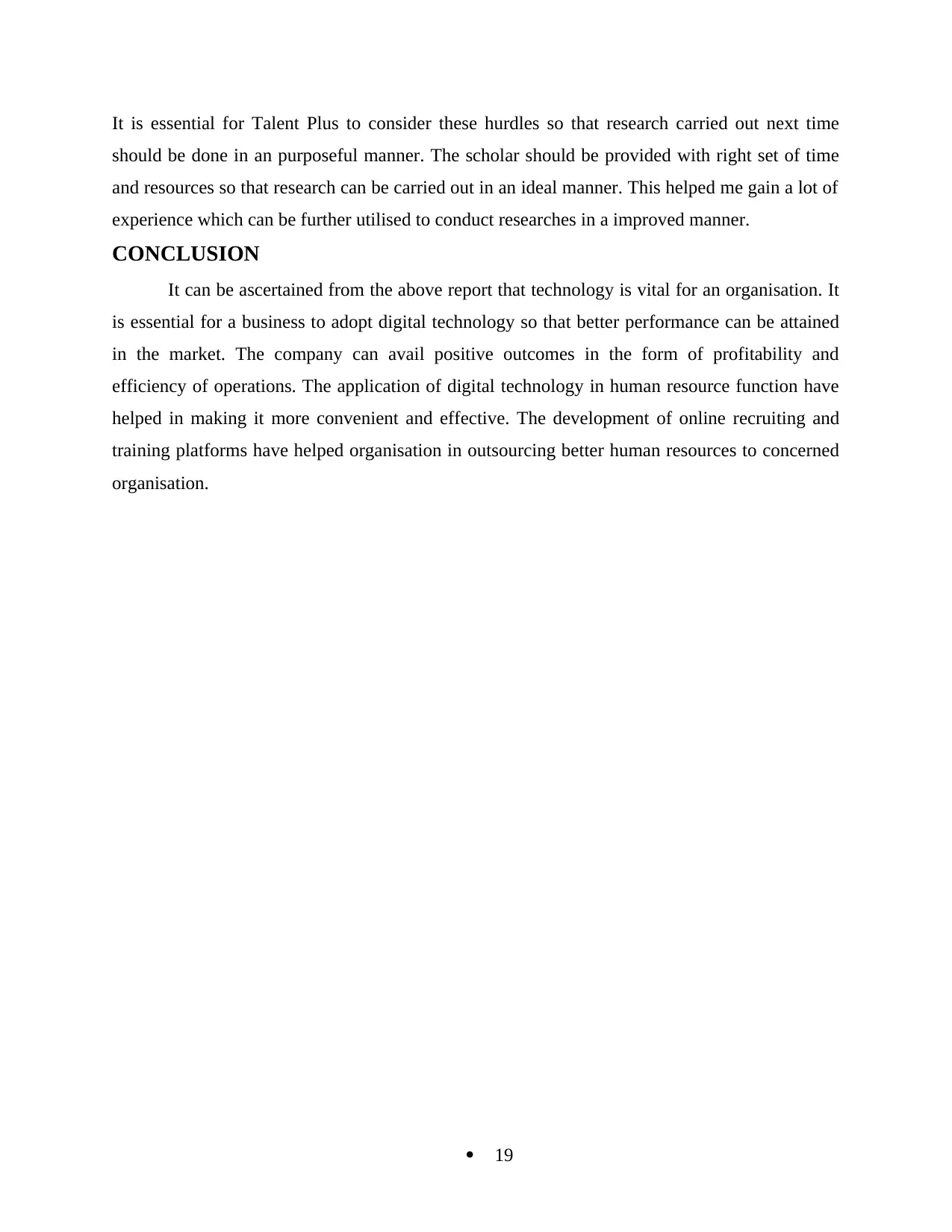
It is essential for Talent Plus to consider these hurdles so that research carried out next time
should be done in an purposeful manner. The scholar should be provided with right set of time
and resources so that research can be carried out in an ideal manner. This helped me gain a lot of
experience which can be further utilised to conduct researches in a improved manner.
CONCLUSION
It can be ascertained from the above report that technology is vital for an organisation. It
is essential for a business to adopt digital technology so that better performance can be attained
in the market. The company can avail positive outcomes in the form of profitability and
efficiency of operations. The application of digital technology in human resource function have
helped in making it more convenient and effective. The development of online recruiting and
training platforms have helped organisation in outsourcing better human resources to concerned
organisation.
19
should be done in an purposeful manner. The scholar should be provided with right set of time
and resources so that research can be carried out in an ideal manner. This helped me gain a lot of
experience which can be further utilised to conduct researches in a improved manner.
CONCLUSION
It can be ascertained from the above report that technology is vital for an organisation. It
is essential for a business to adopt digital technology so that better performance can be attained
in the market. The company can avail positive outcomes in the form of profitability and
efficiency of operations. The application of digital technology in human resource function have
helped in making it more convenient and effective. The development of online recruiting and
training platforms have helped organisation in outsourcing better human resources to concerned
organisation.
19
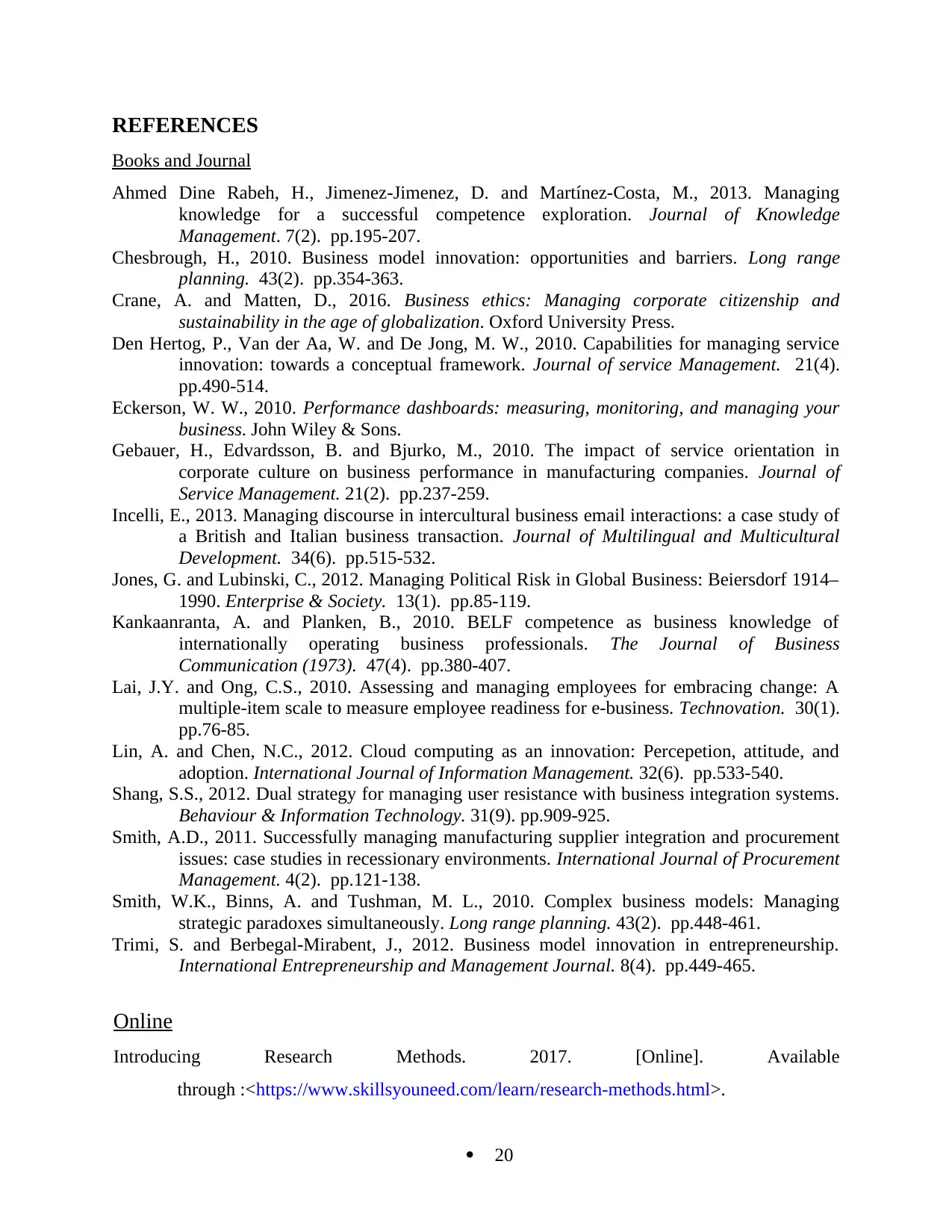
REFERENCES
Books and Journal
Ahmed Dine Rabeh, H., Jimenez-Jimenez, D. and Martínez-Costa, M., 2013. Managing
knowledge for a successful competence exploration. Journal of Knowledge
Management. 7(2). pp.195-207.
Chesbrough, H., 2010. Business model innovation: opportunities and barriers. Long range
planning. 43(2). pp.354-363.
Crane, A. and Matten, D., 2016. Business ethics: Managing corporate citizenship and
sustainability in the age of globalization. Oxford University Press.
Den Hertog, P., Van der Aa, W. and De Jong, M. W., 2010. Capabilities for managing service
innovation: towards a conceptual framework. Journal of service Management. 21(4).
pp.490-514.
Eckerson, W. W., 2010. Performance dashboards: measuring, monitoring, and managing your
business. John Wiley & Sons.
Gebauer, H., Edvardsson, B. and Bjurko, M., 2010. The impact of service orientation in
corporate culture on business performance in manufacturing companies. Journal of
Service Management. 21(2). pp.237-259.
Incelli, E., 2013. Managing discourse in intercultural business email interactions: a case study of
a British and Italian business transaction. Journal of Multilingual and Multicultural
Development. 34(6). pp.515-532.
Jones, G. and Lubinski, C., 2012. Managing Political Risk in Global Business: Beiersdorf 1914–
1990. Enterprise & Society. 13(1). pp.85-119.
Kankaanranta, A. and Planken, B., 2010. BELF competence as business knowledge of
internationally operating business professionals. The Journal of Business
Communication (1973). 47(4). pp.380-407.
Lai, J.Y. and Ong, C.S., 2010. Assessing and managing employees for embracing change: A
multiple-item scale to measure employee readiness for e-business. Technovation. 30(1).
pp.76-85.
Lin, A. and Chen, N.C., 2012. Cloud computing as an innovation: Percepetion, attitude, and
adoption. International Journal of Information Management. 32(6). pp.533-540.
Shang, S.S., 2012. Dual strategy for managing user resistance with business integration systems.
Behaviour & Information Technology. 31(9). pp.909-925.
Smith, A.D., 2011. Successfully managing manufacturing supplier integration and procurement
issues: case studies in recessionary environments. International Journal of Procurement
Management. 4(2). pp.121-138.
Smith, W.K., Binns, A. and Tushman, M. L., 2010. Complex business models: Managing
strategic paradoxes simultaneously. Long range planning. 43(2). pp.448-461.
Trimi, S. and Berbegal-Mirabent, J., 2012. Business model innovation in entrepreneurship.
International Entrepreneurship and Management Journal. 8(4). pp.449-465.
Online
Introducing Research Methods. 2017. [Online]. Available
through :<https://www.skillsyouneed.com/learn/research-methods.html>.
20
Books and Journal
Ahmed Dine Rabeh, H., Jimenez-Jimenez, D. and Martínez-Costa, M., 2013. Managing
knowledge for a successful competence exploration. Journal of Knowledge
Management. 7(2). pp.195-207.
Chesbrough, H., 2010. Business model innovation: opportunities and barriers. Long range
planning. 43(2). pp.354-363.
Crane, A. and Matten, D., 2016. Business ethics: Managing corporate citizenship and
sustainability in the age of globalization. Oxford University Press.
Den Hertog, P., Van der Aa, W. and De Jong, M. W., 2010. Capabilities for managing service
innovation: towards a conceptual framework. Journal of service Management. 21(4).
pp.490-514.
Eckerson, W. W., 2010. Performance dashboards: measuring, monitoring, and managing your
business. John Wiley & Sons.
Gebauer, H., Edvardsson, B. and Bjurko, M., 2010. The impact of service orientation in
corporate culture on business performance in manufacturing companies. Journal of
Service Management. 21(2). pp.237-259.
Incelli, E., 2013. Managing discourse in intercultural business email interactions: a case study of
a British and Italian business transaction. Journal of Multilingual and Multicultural
Development. 34(6). pp.515-532.
Jones, G. and Lubinski, C., 2012. Managing Political Risk in Global Business: Beiersdorf 1914–
1990. Enterprise & Society. 13(1). pp.85-119.
Kankaanranta, A. and Planken, B., 2010. BELF competence as business knowledge of
internationally operating business professionals. The Journal of Business
Communication (1973). 47(4). pp.380-407.
Lai, J.Y. and Ong, C.S., 2010. Assessing and managing employees for embracing change: A
multiple-item scale to measure employee readiness for e-business. Technovation. 30(1).
pp.76-85.
Lin, A. and Chen, N.C., 2012. Cloud computing as an innovation: Percepetion, attitude, and
adoption. International Journal of Information Management. 32(6). pp.533-540.
Shang, S.S., 2012. Dual strategy for managing user resistance with business integration systems.
Behaviour & Information Technology. 31(9). pp.909-925.
Smith, A.D., 2011. Successfully managing manufacturing supplier integration and procurement
issues: case studies in recessionary environments. International Journal of Procurement
Management. 4(2). pp.121-138.
Smith, W.K., Binns, A. and Tushman, M. L., 2010. Complex business models: Managing
strategic paradoxes simultaneously. Long range planning. 43(2). pp.448-461.
Trimi, S. and Berbegal-Mirabent, J., 2012. Business model innovation in entrepreneurship.
International Entrepreneurship and Management Journal. 8(4). pp.449-465.
Online
Introducing Research Methods. 2017. [Online]. Available
through :<https://www.skillsyouneed.com/learn/research-methods.html>.
20
Secure Best Marks with AI Grader
Need help grading? Try our AI Grader for instant feedback on your assignments.
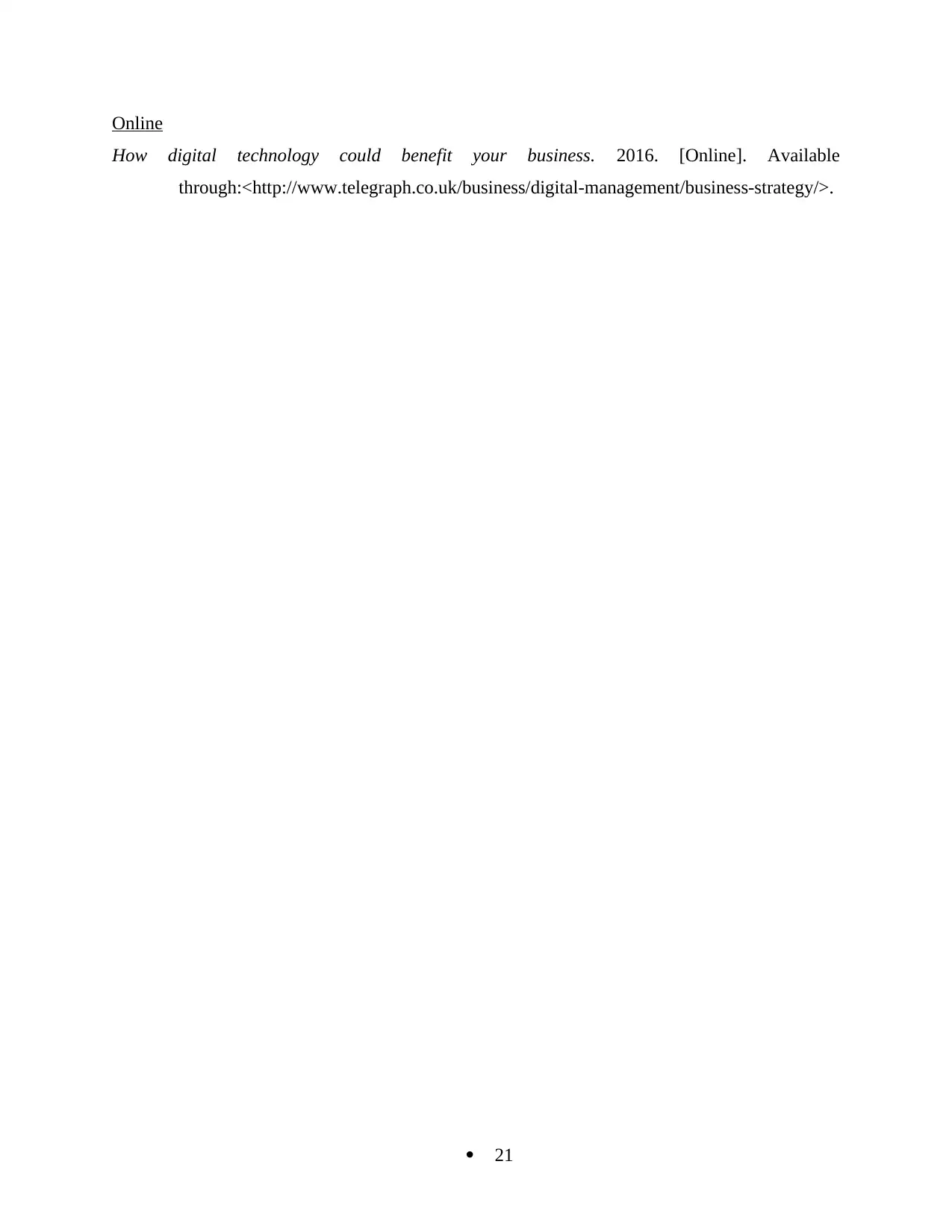
Online
How digital technology could benefit your business. 2016. [Online]. Available
through:<http://www.telegraph.co.uk/business/digital-management/business-strategy/>.
21
How digital technology could benefit your business. 2016. [Online]. Available
through:<http://www.telegraph.co.uk/business/digital-management/business-strategy/>.
21
1 out of 23
Related Documents
Your All-in-One AI-Powered Toolkit for Academic Success.
+13062052269
info@desklib.com
Available 24*7 on WhatsApp / Email
![[object Object]](/_next/static/media/star-bottom.7253800d.svg)
Unlock your academic potential
© 2024 | Zucol Services PVT LTD | All rights reserved.





